Maja Voje's Blog, page 3
July 4, 2025
Make the Best Out of This Summer
Dear GTM Strategist,
Happy 4th of July to our American friends. I hope you have a fantastic holiday and fuel yourself with the inspiration, motivation, and joy! 🎆
Q3 is here - how to get the best of it?
In our business, July and August are slower in terms of sales, business development, and events. We finally have more time to work on new product development, content strategy refinement, and those good old things that we have been passively avoiding for 6 months now because we were just too busy.
So my husband Anze and I went for a mini retreat to work on our Q3 plans - more specifically, OKR-ing. In this Substack, I want to share some of the best planning and making sure that it is done practices that we’ve developed over the years of ruthless execution and radical honesty when reflecting why some plans “stuck on paper”.
We’ll dive into:
Process of preparing OKRs
How to turn your OKRs into your operational compass
How to make an AI assistant that will coach you through the process.
And I have a sweet summer deal for you. 🌴
ALL my materials, including:
100+ assets from the checklist
50+ pages of masterclass transcripts
350+ pages of the book
are ready for you to build your custom GTM coach.
They are packed at a special price $297 (40% saving).
This offer is valid for a week (until July 10th).
We prepared instructions on how to get up and running quickly, so you can create your own custom AI GTM coach using trusted materials that work in practice, not some SaaS vendor's SEO articles or hallucinogenic intelligence.
You need trusted, proven knowledge assets, a guided approach, and your proprietary intelligence to make it work beyond “what your competitors can get too”.
So, let’s get started!
Love them or hate them, best-in-class tech companies use OKRsA technical founder I coach said it beautifully:
“I hate OKRs.
They work.”
But first, what are OKRs?
From The Go-To-Market Strategist by Maja Voje:
OKRs (Objectives and Key Results) are a simple goal-setting system that helps teams align around what matters most and measure progress clearly.
“Objectives are qualitative, directional goals. Key Results are specific, measurable outcomes that indicate whether progress is being made toward the objective.”
Here is a quick example by a PLG company to illustrate how they are done:
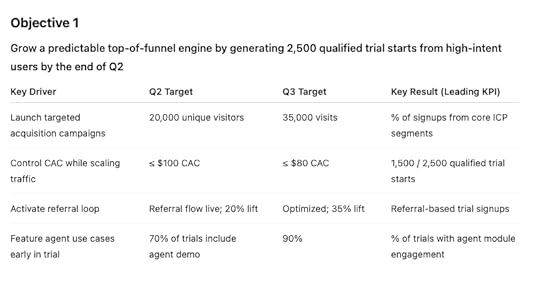 Real case anonymized by ChatGPT
Real case anonymized by ChatGPTA recent study by Steven Macdonald, founder of OKRs Tool (n=200 startup founders), showed that startups that have OKRs:
68% of startups hit $1M ARR faster
39% saw impact in 1–3 months
42% hit their goals regularly
89% wish they had started earlier
But the devil’s in the details.
Setting them up is the “easy part”.
Sticking to them makes the real difference.
5 tactics to make OKRs work for youMost teams wait too long to take goal-setting seriously.
If you don’t know where you are going, how will you know you’ll get there?
Also true: investors want these numbers.
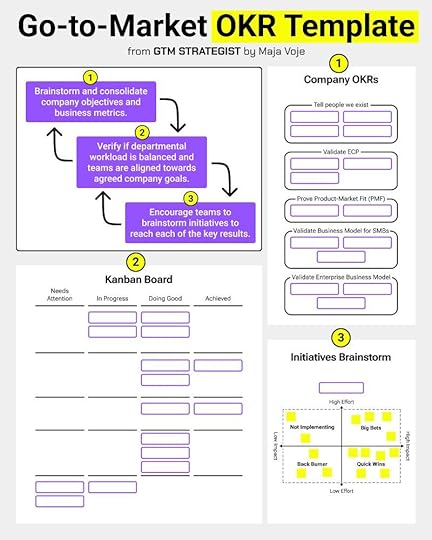
How to turn your OKRs from a “piece of paper” to a powerful compass that will help you win the market?
1. Don’t wait for the perfect moment
OKRs are not for when you're ready. By the time you feel the chaos, it's already costing you. I even recommend OKRs to a one-person business, but when you have a team of 5-10, serious issues with alignment will become apparent. And big news - you don’t have to do them quarterly; you can make them today by the end of the year, or whatever makes sense to you.
2. Start with one OKR per team/owner
An ideal place to start with OKRs is 1-3 Objectives (one product, one marketing/growth/sales, one fundraising/building a sustainable business model is a fine frame for the first objectives), especially if you work in a team of 1-10 people; 1-2 will be plenty to handle. Do not set up 10 objectives and assign them to the same people, you’ll probably stretch them too thin. Keep things light and manageable.
3. Review daily/weekly - not quarterly
Some teams treat OKRs like a quarterly checkbox. Big mistake. I read mine daily at the start of the quarter (Anze says that’s maniac behavior - but it works). Make sure your OKRs live in a visible, shared space. Revisit them weekly. And stay flexible. If something shifts - market, team, opportunity - adjust. Just don’t lose sight of the bigger picture and your mission-critical.
4. Anchor OKRs in actual work
OKRs are not ideas or aspirations. They’re prioritization tools. Ground them. Put them to your Jira, Notion, ClickUp - wherever you track tasks. Make sure you put deadlines for key results in your product to a sprint, roadmap item, or campaign - and reserve time for them. There will always be something urgent/interesting/FOMO - but the work is not getting done by itself.
5. Give every KR an owner
No owner = no outcome.
If everyone’s responsible, no one is.
Assign clear owners. Align OKRs with what motivates them—ideally, co-create them to ensure alignment. Don’t just cascade goals and hope for buy-in.
Here’s the question:
If your team is too busy for OKRs, are you leading them toward the future, or just managing the present?
You can’t expect 100% focus, but you can reserve 20% of their week to make a meaningful impact. If you’re serious about OKRs, make space for them.
Outsource Your Discipline: Create an AI GTM Coach That Holds You to the PlanMy personal GTM AI coach is called Coach Nova 🛰️, and I speak with it at least five times a day.
Coach Nova is trained to be concise, non-hyped, and realistic. I taught it to answer like Goggins, Bedros, and Hormozi. Over-hyped and friendly communication can be off-putting, and ChatGPT, “not each line that I write is a significant step forward to my goals!” It is just a line that may or may not work. I need someone who will be brutally honest with me and push me to act. No excuses.
But everyone has their own motivation style, background, and knowledge. Therefore, to get the best results possible, I encourage you to build your own AI GTM coach this summer.
Here is how:
Get “GTM in a Box” - all my knowledge assets at the BIGGEST discount this year; $297 for a book, checklist with AI prompts, and a 5-hour video masterclass.
We prepared all the assets in the right format (masterclass video transcripts, book PDF) so you can easily upload knowledge assets to your AI tool (ChatGPT, Claude…).
You can add some of your knowledge assets.
You can use my instructions or match them to your style - no worries, we prepared step-by-step instructions on how to set everything up, no coding (d’oh!)
And you got it!
It is cheaper than a single session with me - how cool is that 🤠
Even if you are not into “vibe marketing,” those proven materials will save you tons of time, produce results and ROI like they have for more than 8,500 people so far.
The deal is valid until July 10th.
Cool - I hope you’ll take me on the challenge.
Have a great Q3 and promise me that you will commit to some objectives!
I am cheering you on!
(or like my Coach Nova would say - stop thinking, start doing)

June 27, 2025
The GTM Outreach Playbook: From Triggers to Demos
Dear GTM Strategist!
In June, I trained 35 startup teams.
31 of them were already doing some form of outreach.
That beautiful, proactive approach where you don’t sit around waiting for leads to magically appear. You go out and create opportunities.
But here’s the kicker:
Most of these teams were making obvious, preventable mistakes. Some were just pitch-slapping strangers. Few had a structured outreach campaign or even knew who their ideal customer was.
Meanwhile, they were burning resources on content and conferences when they were probably just 50 focused emails away from landing their next breakthrough client.
Outreach isn’t a numbers game.
It’s a relevance game.
I wrote this guide in the hope of helping you navigate a battle-tested system for transitioning from "just reaching out" to "booking qualified demos." And I was not alone on this mission - PredictLeads pitched in with templates and triggers based on their 92 million companies database.
Let’s get some ICP-fit demos, people!
Unleash the power of outreach. 💪

This post is sponsored by Momentum - an enterprise listening platform for revenue teams that uses advanced AI agents to transform your customer conversations— emails, calls, support tickets—into actionable insights for revenue success.
Most GTM teams are sitting on a goldmine of CRM data, but 90% of it is fragmented, outdated, or invisible to AI. The AEIOU Framework by Momentum is how leading GTM teams fix that.
Get the 56-page AEIOU Framework white paper with examples of AI agents that actually drive revenue.
Explore the white paper by talking to the AI agent (ask it: "Can you give me a high-level walk-through of this research report?") here.
Or download the full report here:
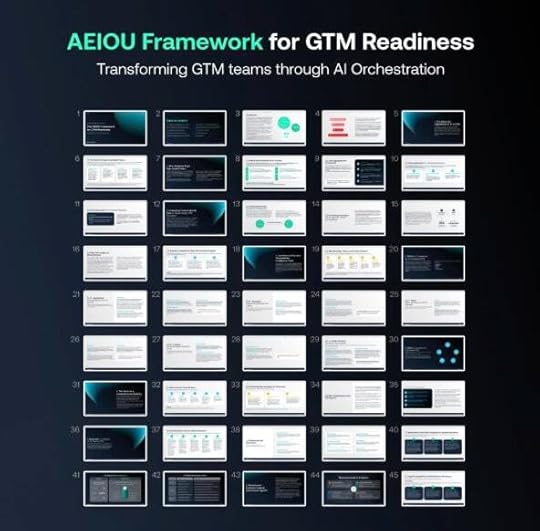 Outreach is like a stew - it needs multiple ingredients
Outreach is like a stew - it needs multiple ingredientsThis is where I like to start when teams are working on their first structure's outreach campaign:
“If you spray and pray, you’ll get your domain blacklisted, burn some bridges and get blocked from LinkedIn.”
C’mon, just kidding - I am not a monster.
But I have to be realistic, too. Many founders waste months on “thought leadership”, “networking” at conferences, and writing long LinkedIn posts that never lead to real business.
I tell them outreach still crushes it - it’s one of the fastest, highest-ROI GTM channels out there. But it only works if you do it right.
In a world flooded with lazy, AI-written spam, we have to do better. And then I give them this recipe:
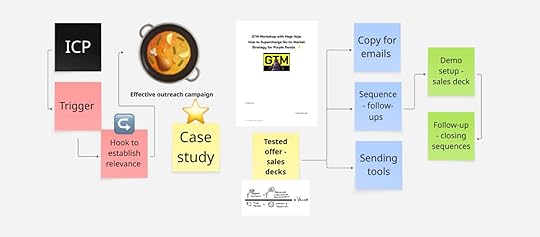 Ingredients of a good outreach strategy
Ingredients of a good outreach strategyOn your outreach journey, you’ll need to nail:
Your Ideal Customer Profile (ICP) - or a set of them to test (more advanced)
Knowledge of triggers - what would make someone interested in buying
Hook to establish the relevance - what is the problem of my ICP, what do I offer, and why should they care about this now (what’s in it for them)
Case study, video, or a knowledge resource
A tested offer and sales decks
Copy for emails (multiple-touch sequences)
Tech stack to send this at mass
Plan for your demo and follow-up sales process.
That’s it.
Nobody will blame you for starting manually by listing 50 people that fit your ICP hypothesis and craft highly personalized emails to engage them and get them to a demo.
But eventually, you’ll run out of personal contacts, get diminishing returns, and will have to learn how to do this at scale regardless.
Relevance is sending the right message to the right person at the right time.
And today, technology can help us be “shut up and gimme your booking link” level relevant.
Let me show you how.
🎯 Outreach only works when you know who you’re talking toStart with clarity. Your outreach is only as good as your ICP.
One of the founders I work with sent out 3000 messages on LinkedIn and booked 6 meetings.
Is that good or bad?
Well, if those meetings converted, it would be great - but they did not.
Outreach wasn’t converting - not because of the message, but because he was targeting the wrong audience. Those who did not care about the product had questionable willingness to pay and happily moved on with their lives after seeing his message.
He defined ICP as:
SaaS companies with $5–10M ARR
2–5 years old
Based in the US and Canada
Decision maker: Head of Growth
And that is too vague. There are ~13,500 companies that he could potentially target and the attempt of the message was something down the line:
“Hi, I see you lead growth at [company name] - did you see organic reach dropping? I have - and we solved that for X companies including Y that increased their sales in 30 days by ZZ%. Wanna hear more?”.
I mean, it's not the worst thing I’ve ever gotten. But he can do much better. How?
Use trigger events to find warm leads - and reel them in 🪝Instead of mass-sending to 13,000 addresses, we asked ourselves a question: how can we recognize from their externally detectable behaviors that someone would be interested in that AI GTM solution?
Here are some of the ballpark ideas:
They gave a testimonial to a competitor
They just hired a new GTM lead
Is actively searching for 10 AI-related roles
They raised a funding round
Each of these is a trigger to start a contextual, relevant conversation.
Example message:
"Congrats on the Series A and hiring a new RevOps lead! We help SaaS teams like [Competitor X] streamline onboarding during growth spikes. Want me to show you how it works?"
Could we do better? Sure! How could I resist this: 😍
 The only outreach message I answered this week (FOMO was real)
The only outreach message I answered this week (FOMO was real)But we work with what we have.
To help you find the best triggers for your outreach, I asked PredictLeads to put together a mega list of triggers exclusively for readers of my newsletter - and they delivered.
PredictLeads is a global data provider trusted by companies like Clay, Copy ai, Dealroom, and Lavender. Their focus? Daily crawling real-time business signals (like hiring sprees, funding rounds, product launches, tech stack changes, website revamps…) from over 92 million companies to help GTM teams act when the timing is just right.
You can plug these signals directly into tools like Clay or use their API to fuel custom prioritization, personalization, and scoring models.
They’ve made the trigger list completely free - plus you’ll find real outreach hook examples inside.
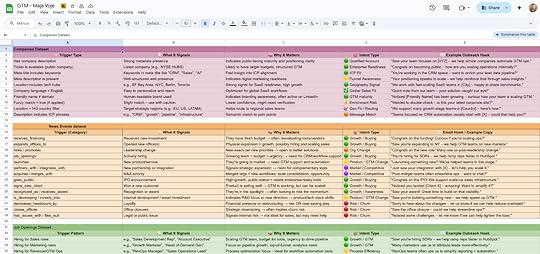 You can access the sheet here (outreach hook examples inside)
You can access the sheet here (outreach hook examples inside)And they also prepared an overview of a data-driven outreach strategy:
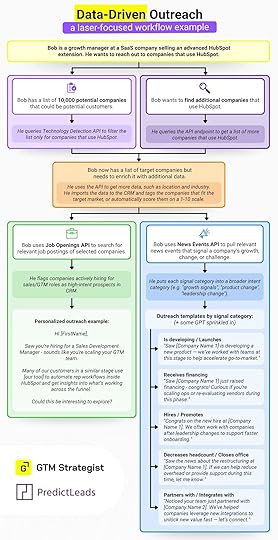 Dive into the full example here: https://miro.com/app/board/uXjVIpEyq7U=/ (much to grasp)
Dive into the full example here: https://miro.com/app/board/uXjVIpEyq7U=/ (much to grasp)Study the spreadsheet (thanks PredictLeads ♥️) and if you have a serious outreach use case that needs more advanced data structures, such as this one, give them a try. They offer 100 free credits a month, but if you’d like to give it a thorough try, contact them, tell them you learned about them through GTM Strategist - and you will get 1000 FREE credits.
From hello to demo: Crafting an outreach sequence that convertsNo idea why so many people still make this mistake 🤷: They treat outreach as “one shot, one opportunity” and fill their intro outreach message with everything (who they are, how many years in the business, 2 case studies, link to the demo call 💥- pitch slap).
Huge no! You need to initiate a conversation and add value. The first message is intended to pique their interest and continue the conversation. Typically, we use 3-7 messages in an outreach sequence. Here’s what an effective sequence includes:
Message 1 – Trigger + Hook (why them + why now)
Message 2 – Value drop (case study, insight, or Loom video)
Message 3 – Follow-up with a call to action ("worth a look?")
Keep each message short, relevant, and written like a human.
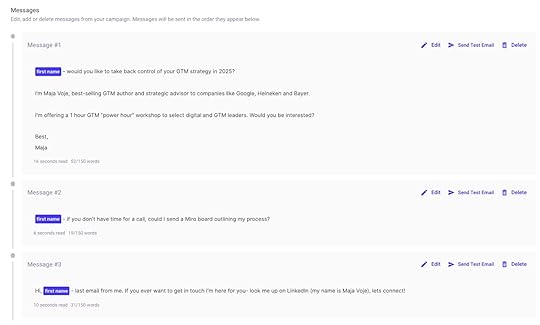 Here is a super simple example of the messages I tested.
Here is a super simple example of the messages I tested.Do not send demo links in the first message - it's brute and a shortcut to spam reports.
If all this sounds too complex, let me set up more realistic standards:
Level 1: Manual & Hyper-personal
1:1 messages to 50-100 hand-picked leads
Goal: Validate triggers, hooks, and ICP
Example: A founder that I worked with tested 2 ICPs - a technical founder SaaS and a founder of ecomm, Europe, min $1 million ARR. He put together a list of his contacts from network, we worked on an outreach message, and out of 50 people contacted, he booked 20 demos. We got a clear insight that one of these ICPs will not work because people do not understand the product and see value in it.
Level 2: Semi-Automated
Use a tool like Instantly (email) and Heyreach (LinkedIn) to scale sending, still with contextual inserts
Goal: 1000–2000 contacts
Example: A team of co-founders that I work with sent out 1000 LinkedIn invites to hard-to-reach ICP (no text), approximately 100 connection requests were approved, and they booked six enterprise demos from this campaign. We expect one deal to close.
Level 3: Engine Mode
Refined ICP + message + proof = scalable outbound engine
Combine with retargeting and inbound for max compounding
Example: A company I work with went through stages 1 and 2 in Q2, and now we’re orchestrating outbound as a full GTM motion - building a data and tech stack with Clay to generate a steady flow of high-fit leads. We're layering in AI-assisted workflows for mass-personalization and light ABM to create multi-touchpoint campaigns across email and LinkedIn, making every message count.
Level 4 - AI SDRs? 🤠
Maybe …
But let’s first make some money from the stage that we are currently on.
Outreach isn’t about being louder.
It’s about being specific enough to matter.
Hope this was helpful and worth your time and attention.
Really study those triggers - it will open up your mind from “bother strangers” to “adding value to the ICP. I know outreach is not specifically enjoyable for most of us - but we can get better at it; it is just another muscle to train and grow.
As I like to say to my folks:
“What is the worst thing that can happen? Someone can block you, send you a nasty message back, or think that you are annoying. Can you live with it?”
Yes, if the high is worth the pain. So get ready to send those 50 emails that are separating you from the next deal you close ✌️
Want more?If you’d like to get PROVEN examples of outreach campaigns (actual copy), sales decks, offers, and case studies with prompts that will help you apply them to your use case, grab a mega-library of 100+ GTM Templates here.
Get Started with Outreach using the GTM Checklist
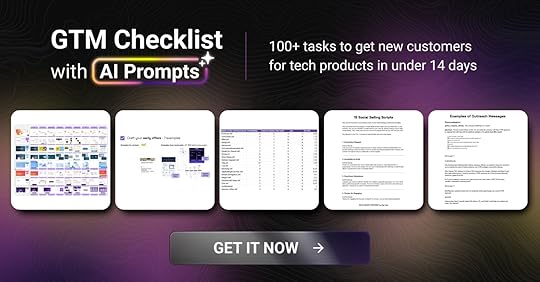
Thanks for reading GTM Strategist! Subscribe for free to receive new posts weekly and support my work.
June 20, 2025
How To Build and Grow a Successful Newsletter in 2025
Dear GTM Strategist!
After a year and a half of being married to the idea that I should create content daily, we managed to achieve a notable milestone in growing our community: 65K LinkedIn + 20K newsletter subscribers.
And I first want to thank you and give you a GIANT kudos for learning with me. Without you, this would not be possible - I appreciate you to the moon 🙏 and I wholeheartedly wish you the same.
So, would it make sense for you to build your personal brand and attract new business opportunities by thinking and building in public?
Even the technical founders I mentor agree that all the AI advancements make content creation easier than ever. I have had my teams implement content systems in <7 days. Sure, it does take a month or so to get good at it - but “I do not know what or how to write” or “lacking time to do it” is not a valid excuse anymore.
What is a totally valid objection though is if your target audience is not on LinkedIn, does not read newsletters, or if your time has too high of opportunity cost that could produce better ROI elsewhere. But you either have time or money (ideally both) on your hands, so if you somehow sold on this idea of “building in personal brand”, I have a treat for you.
In this newsletter, I will:
Walk you through the evolution of my content creation
Share some stories and tactics that worked well for me, aka evolution
Present you tools that I use for my content creation - nothing fancy
Let you know why I do not want to make this newsletter paid
Give you a couple of hints about what is next
It will be semi-personal story-telling (feel free to skip if that ain’t your spiel), but I’ll make sure that you can still grab some good ideas, tactics, and frameworks that you can apply to your business - because I personally judge good content only through the lens of “what is in it for me” and I want you to have something tangible out of investing your time here.
I was never inspired to be an “influencer/content creator” - it all started as I was building demand for my GTM Strategist book launchPeople say the hardest thing in business is to know your why, to find the motivation to get started, and stamina to continue. Well, in my case, that was easy. In 2023, I invested one year of my life into writing a book, went to isolation (maker mode), which was great for productivity, but terrible for marketing. 3 months before the launch, I had 100-something emails on my waitlist.
I panicked. I had a product and instead of raving fans, there were crickets. 🦗
So I went to turbo mode. Mission critical task was to build a 3K waitlist for the launch and started what I do to these days: 5-7 LinkedIn posts a week + one newsletter.
I did have something valuable - a writing habit. I could sit for hours and just get the work done, but every channel has its own laws and you cannot really brute force through it. You need reps to get good at it.
I made a commitment and the number of emails became one of my core weekly marketing KPIs. I have been following it religiously to this day.
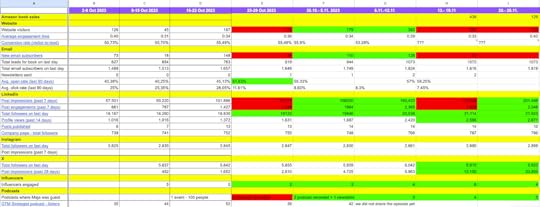 This is how I was getting ready for my launch - exact metrics that I have trackedEvolution and main drivers of growth of the newsletter lists
This is how I was getting ready for my launch - exact metrics that I have trackedEvolution and main drivers of growth of the newsletter listsI got my first 500 subscribers by inviting my personal contacts to the email list. Then I started to include a call to action “subscribe to my newsletter” more frequently on LinkedIn, but that was the period of linear growth. I needed boosters ⚡

What worked well with my audience growth:
Collaborations with other creators 🤝: Working with mega content creators and my role models, such as Kyle Poyar, Paweł Huryn, Aakash Gupta, contributed thousands of subscribers to the community. 🙏 It is such a great way to introduce your work and mission to already thriving communities and I am forever grateful to them for giving me a chance. That was the beginning of not-so-linear growth :)
Substack recommendations loops 🔁: The only reason why I stick to Substack as an email platform is the recommendation engine with other content creators. It is a significant driver of signups (22.5% of the email base)

Lead magnets 🧲: My friend and GTM AI coach Jonathan M Kvarfordt, Head of GTM Growth at Momentum, said it best: “Make them so good that people would want to pay for it” - that is my mojo. Every time I invent a new framework, I’ll fuel its launch with a lead magnet campaign on LinkedIn.This tactic has diminishing returns at the moment and I do not want to overuse it because it does not attract the same quality of emails as content, but do not hate the player, hate the game. It still brings attention to the resource you want to promote.
I bet some of you might be thinking at this point: wow, so much effort, is it worth it?
Isn’t this newsletter free?
Yes, and I plan to keep it that way. This is me paying forward. When I started my career in growth back in 2012, I treated blog posts from Sean Ellis, Brian Balfour, Andrew Chen and other evergreeners like a bible. They shaped the way I think and grow, and I hope that some of my work will have a similar impact on the new generations of entrepreneurs, growth experts, product ninjas, and GTM strategists.
Huge thanks to supporters of the GTM Strategist media 🙏I will not use the word sponsors, because we are not selling billboards; we intend to build partnerships with supporters of our media stream. When I had to decide between direct monetization (charging you a $7 subscription vs. media model), I opted for the media model because working with partners brings a lot of value to the ecosystem and I personally learn so much when interacting with their products and team members myself. They are an important part of our ecosystem.
So far, we have worked with 25+ partners on our content.

We have co-created content, developing assets and creating events with all of them, tackling GTM challenges, solving pressing business problems and getting our processes in order. I appreciate each and every one of the partners who supported our mission, but most of all, I would like to thank to our long-term partners:
Miro
Amplitude
Momentum
Ahrefs
Userpilot
Clay and
Tidio
You are amazing! Thank you so much for supporting GTM communities and investing in high-quality asset creation 🙏 and helping us to keep our content free with your valuable contribution and knowledge inputs.
Now it’s time to roll up your sleeves and get some work done, ain’t it?
How do I create content, and what can you learn from me and apply to your business?
Content creation process, templates, and frameworksGrab your headphones, coffee, and enjoy the beats of classical music (I play Dvořák today - tune in 🎶) on a Sunday morning - we’ll get some work done ✍️
First, I will walk you through the main assets that not only I use, but I teach all my teams to follow a similar structure. This is what you need:
Strategic narrative - what is your unique point of view
Content pillars - what are your topics, what are you writing about
ICP (Ideal Customer Profile) - for whom you are writing, what problems do they have, what do they want
Content calendar - what if your publishing frequency and when you publish (with most of my teams, we start with 2-3 posts a week per founder and a biweekly newsletter), and so important
Design system - in the age of AI-assisted content, that can be a huge differentiator
System to define hooks and structure your posts (AI assistant) and
Analytics system - how do we measure results and create feedback loops?
 You can get all the templates in my GTM Strategist Checklist with AI prompts
You can get all the templates in my GTM Strategist Checklist with AI promptsNot vibing with this idea?
Let me help: Inbound is a powerful GTM Motion (predictable and scalable way to get customers). It does take 3-6 months to kick in - but guess what - as a pro, you are used to delayed gratification by now.
And since there are a lot of technical people reading this newsletter:
You do not have to sound like a wounded deer and whine in public to make it happen.
Personal branding does not mean sharing photos of your children or post-workout glow pics on LinkedIn. You don’t have to reveal any personal information, just lead with knowledge and stay laser-focused on adding value to your ICP.
I spend 1 day a week creating content for both - 5 LinkedIn posts and 1 newsletter. I have help with design, and my partner in life and business Anze Voje (add him on LinkedIn - maybe he will start posting 🤠), gracefully and patiently edits each version for you with love for good grammar, readability, and consciousness.
And that is it. It’s not rocket science.
I hope you enjoyed this one and grabbed an actionable idea or two that you can implement.
Let me know in the comments if you have some specific questions.
Thank you so much for reading this newsletter, supporting GTM Strategist, providing us feedback, and sharing it with your colleagues and teams. 🙏

If you want to support my work, here is how we can exchange value:
Get the best-selling GTM Strategist book + 20 frameworks (workshops) + online course.
Leverage the 100-step GTM Checklist with AI prompts tested on 800+ launches with templates (emails, launch plans, posts, landing pages), which will guide you from getting ready to launch to an impactful launch and scaling stage.
Guide your team to successfully choose ICP (target market), pricing, positioning & selection of best GTM Motion (channels, tactics) with GTM Masterclass - includes 6 hours of video content.
If you’re interested in content partnership with GTM Strategist, reach out to grow@majavoje.com.
June 13, 2025
An Attractive Value Experience (AVX): Framework for Building AI Native Go-to-Market Foundation
Dear GTM Strategist,
If you’ve ever felt that traditional campaigns aren’t built for today’s fast-paced and AI-driven world - you’re not alone.
That’s why I invited Anurag Wadehra (ex-Google, P&G) - one of the most insightful minds in AI-native go-to-market strategy - to write a guest post for GTM Strategist.
Anurag created a powerful new framework: the Attractive Value Experience (AVX). It’s a practical, flexible unit designed for AI-native GTM teams who want to deliver value fast, with precision and accountability.
What’s inside:
Why classic GTM programs fail in AI-native environments
The 6 components of an Attractive Value Experience (AVX)
How Human-AI Cognitive Pairing reshapes GTM execution
Real-world AVX journey examples, like AI inventory optimization
A free worksheet to help you design your first AVX today
This one’s for builders who want their AI product to actually resonate with users and buyers. Let's dive in!

This post is sponsored by UNTAMED - a content execution partner for teams and companies that need ongoing, scalable content that converts. With a unique subscription-based offering, you can get unlimited designs and content requests.
They’re offering an exclusive 10% discount for all GTM strategist subscribers.
The landscape of enterprise software and AI is shifting rapidly, demanding a fundamental re-evaluation of how businesses go to market. Traditional GTM playbooks, while still relevant in parts, often fall short in harnessing the transformative power of Artificial Intelligence. For entrepreneurs building the next generation of AI-first or AI-enhanced solutions, a first-principles approach is not just an advantage—it's a necessity.
This post outlines a step-by-step framework to rethink your GTM strategy, anchored by the concept of the Attractive Value Experience (AVX) and with Human-AI Cognitive Pairing, powered by an ecosystem of AI agents.
How AI Disrupts GTM CampaignsIn today’s AI-driven GTM world, why are traditional campaign architectures still the default? Programs, campaigns, and tactics were designed for a pre-AI era—too bulky, too disconnected to keep up. AI is tossed into content, targeting, analytics—but where exactly should humans step in? Who owns the decisions? This lack of clarity creates friction, not flow.
Are we delivering value that truly resonates with buyers, or just amplifying noise? When AI speeds up execution but humans struggle to guide it, who’s accountable for meaningful outcomes? And how do we avoid wasting effort on fragmented campaigns that confuse rather than compel?
The root issue is simple but profound: the unit of GTM execution is outdated for human-AI collaboration.
Campaigns and programs are too large and vague, channels too siloed, and personas too generic to flex with real-time buyer needs—or to harness AI-human collaboration effectively.
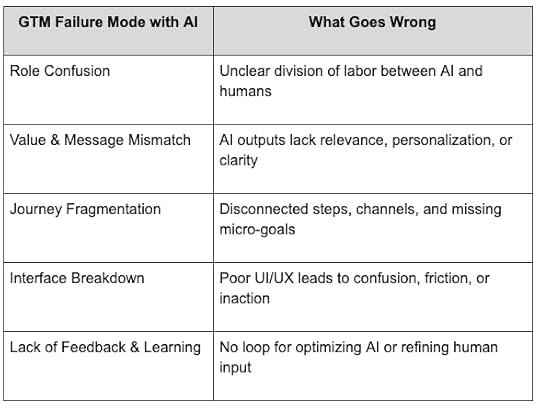
So how do we rethink GTM for a world where AI isn’t just a tool but a partner? Where value is not an abstract goal but a tangible, micro-experience that aligns with buyer journeys and human judgment? The answer lies in a new, sharper GTM building block—one designed for continuous learning, intelligent pairing, and crystal-clear value delivery.
The Attractive Value Experience: A Foundational AI Native GTM UnitThe Attractive Value Experience (AVX) is a proposal for the foundational unit of GTM in the AI era—one that aligns with how buyers actually experience value and how teams can intelligently deliver it with AI and Agents. At its core, effective GTM is about consistently delivering value that compels customers forward. We define this foundational unit as an Attractive Value Experience (AVX).
AVX is a meticulously designed, measurable, and iterative micro-journey that attracts a customer with a small, self-contained value prop, engages them intelligently, and then propels them toward a specific immediate goal.
It's a holistic, single-purpose flow where interdependent components are strategically bundled to deliver clear-cut value, optimized for the right level of Human-AI Cognitive Pairing powered by a growing ecosystem of AI agents, and continuously refined.

In short:
AVX is a Micro Experience that
→ Attracts Customer with Value
→ Engages with Intelligence
→ Propels to a Goal
Six Components of an Attractive Value ExperienceEvery single AVX has six components that are necessary to make it functionally complete and effective as a GTM unit. Working in an integrated fashion, these six components deliver an experience that is self contained. Moreover, you can optimize these components based on feedback until the experience (and the underlying value prop) is strong enough to both attract and propel customers successfully to their goals.
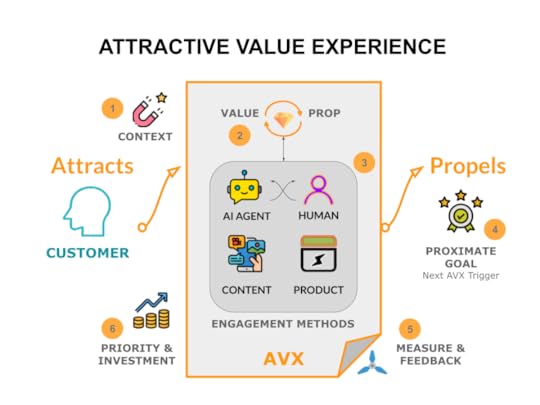
Here are the six components and their roles:
 AVX Examples
AVX ExamplesZoom Webinar

AVXs often take the form of:
An AI-assisted interactive experience that delivers fast insight, outcomes or recommendations
A micro-journey that solves a high-value problem or risk for a specific persona
A proof-of-value tool or workflow that aligns to the buyer/user’s real-world decision-making or usage context
The unit of value in an AVX is intentionally small, clear, and specific to a target persona. It’s designed to be immediately useful, self-contained, and easily measurable — making it ideal for:
Accelerating user adoption and trust
Enabling champions with internal proof points
Driving usage-based expansion and upsell
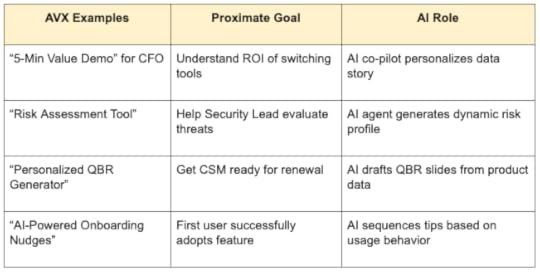 The Power of Human-AI Cognitive Pairing in GTM
The Power of Human-AI Cognitive Pairing in GTMThe true differentiator in AI-native GTM lies in the seamless Human-AI Cognitive Pairing. This isn't about AI replacing humans, but rather AI augmenting human capabilities and vice-versa, creating a synergistic GTM machine that is both scalable and deeply impactful. There are multiple levels of Human AI pairing feasible. Here is a basic one:

AI for Scale and Precision: AI excels at processing vast amounts of data, identifying patterns, personalizing content at scale, automating routine tasks, and providing predictive insights. This allows GTM teams to operate with unprecedented efficiency and precision.
Humans for Empathy and Strategy: Humans bring empathy, creativity, strategic thinking, complex problem-solving, and the ability to build deep relationships. In the GTM process, they interpret AI insights, craft compelling narratives, navigate complex negotiations, and provide the nuanced touch that AI cannot replicate.
Why This Matters for AI-Native GTMTraditional SaaS go-to-market models — especially those built for large B2B products — are breaking down in the AI-native world:
AI-native products are faster, smaller, and more modular. They often deliver value in specific tasks or insights, not entire platforms.
Buyers and users expect proof of value early. They need to experience tangible value before full adoption or enterprise buy-in.
Human-AI pairing is central to usage. New forms of decision-making, productivity, and workflows are emerging — changing how GTM must prove value.
That’s why the AVX framework is key. It provides a repeatable way to design product-led, AI-native GTM that accelerates time-to-value, reduces friction in buying, and builds trust in intelligent systems.
Building GTM Pathways: Create and Orchestrate AVXs Across Customer JourneyEach AVX is built from three core parts to support customer journey:
Cognitive Pairing (Human + AI)
A clear mapping of how the AI augments, assists, or accelerates the customer (buyer, user or team) in achieving a specific goal or task.
Context-Aware Unit of Value
A modular outcome, action, or insight that aligns to the customer’s real-world process, decision, or metric of success.
Agentic Enablement to Attract & Propel
Designed to be demoed, shared, or used directly by the users and buyers to enable internal alignment, proof of value, and next-step adoption.
Together, these three elements form a durable architecture for a value journey that is:
Attractive (to the right persona)
Valuable (for their success metric)
Experiential (in the form of interaction, not just content)
A string of AVXs can be used to build custom GTM pathways.
Each attractive experience pulls a customer into a value cell, and upon delivery, triggers the next attractive experience. Ultimately, with right optimization of the GTM pathway itself (through AI) this approach helps customers discover the product offering, and reach their business outcome through its consumption.
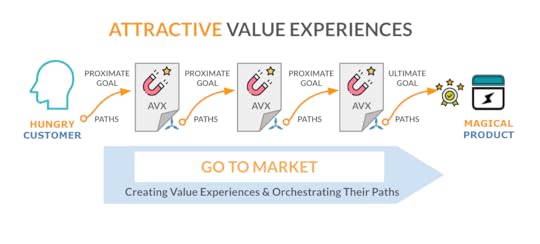
In practice, this pairing manifests across GTM functions and applies to various personas, such as User and Buyer, across all stages of their Customer Journey.
End-to-End Example: Retail – Inventory OptimizationBy meticulously designing and orchestrating multiple AVX experiences, you can build a GTM engine that is both efficient and deeply customer-centric, capable of leveraging the right AI's strengths at every turn.
User Journey – Store Manager / Inventory Analyst
Use Case: AI-powered inventory management and demand forecasting for omnichannel retail.
User Persona: Store Manager or Inventory Analyst
Buyer Persona: Head of Supply Chain or VP of Merchandising
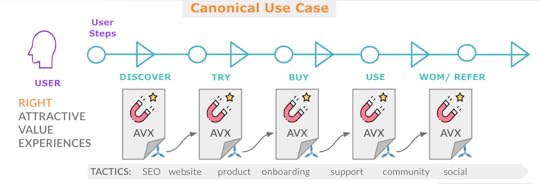
 Buyer Journey – VP of Merchandising / Head of Supply Chain
Buyer Journey – VP of Merchandising / Head of Supply Chain


Note:
AVX Flexibility: AVXs are modular and persona-specific, yet linkable (e.g., usage data feeds business case).
Proximate Goal-Centric: Each AVX advances the journey with a specific, measurable goal.
Human-AI Pairing: AI and agents are embedded across both tracks—not just as backend automation but as a visible partner in delivery.
Five AVX Combination Customer Journey PatternsNo customer journey is linear. So, these AVXs can be combined in various patterns to craft and enable journeys to achieve customer goals.
Below is a summary of the five key ways AVXs can be used as building blocks in go-to-market (GTM) design—like Lego blocks or biological cells—followed by real-world-style examples for each pattern.
AVX as a Modular GTM Building BlockPattern 1: Local Optimization [Lego brick]
What It Means: Each AVX can be optimized independently by refining its 6 elements based on performance.
Purpose: Nail individual moments of value
Example & Outcome: A customer onboarding checklist AVX for new admins. Use case: Focuses on helping an IT admin complete setup within 30 mins. Result: 30% faster time-to-value and 15% drop in setup-related support tickets.
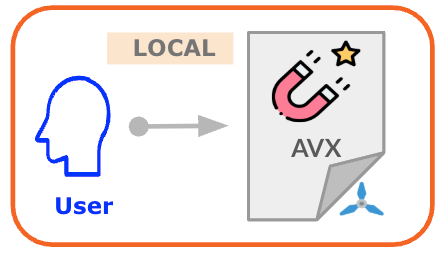
Pattern 2: Sequenced Cascade [Relay Race]
What It Means: AVXs can be linked in a linear sequence along the journey to build momentum toward conversion.
Purpose: Drive engagement across time
Example & Outcome: A sequence from product trial → security validation → stakeholder approval. Use case: Orchestrates the buyer journey for an enterprise IT tool. Result: 2x faster deal cycles and smoother handoffs between sales and legal teams.
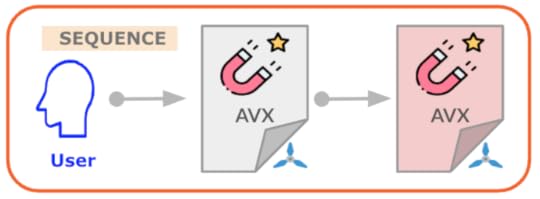
Pattern 3: Parallel Tracks [Threads]
What It Means: Different AVXs can run simultaneously for different segments, channels, or functions.
Purpose: Scale reach without confusion
Example & Outcome: Simultaneous AVXs for CFO (ROI modeling), VP Eng (integration demo), and Procurement (contract Q&A). Use case: Address different stakeholder needs concurrently in a complex sale. Result: 40% higher close rates due to role-specific value delivery.

Pattern 4: Stacked Personas [Big Moment]
What It Means: At one event or campaign, multiple AVXs can serve distinct personas (user, manager, exec).
Purpose: Drive dense engagement and conversion
Example & Outcome: Product pitch deck that combines AVXs for ROI, roadmap confidence, technical feasibility, and procurement clarity. Use case: Tailored pitch for CFO, CTO, and VP Ops in one enterprise meeting. Result: Stakeholder alignment in one session and accelerated decision.

Pattern 5: Channel Adaptation [Custom Fitting]
What It Means: Each AVX can be tailored to a specific GTM channel (e.g. email, live demo, outbound SDR).
Purpose: Maximize distribution efficiency
Example & Outcome: A self-assessment AVX on AI readiness delivered via email, LinkedIn, and partner webinars. Use case: One AVX deployed across three acquisition channels. Result: Increased lead capture volume by 3x without duplicating effort.
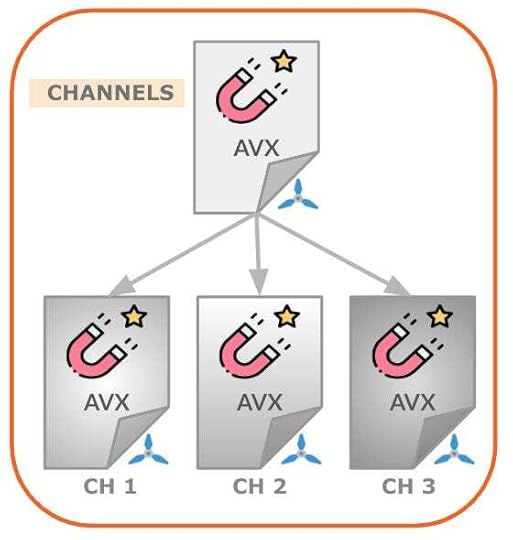
Note that AVXs are:
🔹 Modular: Can be deployed incrementally.
🔹 Composable: Can be arranged into sequences or stacked into bundles.
🔹 Contextual: Aligned to job-to-be-done (user) or business moment (buyer).
🔹 Adaptable: Works across touchpoints, lifecycle stages, and personas.
🔹 Trackable: Each AVX can be instrumented for engagement and conversion.
Therefore, AVX based AI native GTM approach can enable multiple GTM strategies: Product-Led Growth, Product Led Sales, Account Led Sales, Channel and Community Led Growth etc. How to ladder multiple AVXs into these strategies is outside the scope of this document, but an interesting area of work in progress.
Comparing AVX to Other GTM ConstructsSince AVX is a new AI-native GTM framework, it helps to understand how it differs from other common GTM constructs in favor today. It is critical to note that all current GTM units will remain relevant in the near future. Already, they are being used by every GTM practitioner to add and test AI capabilities with hundreds of tactics today.
In many ways, the AVX framework complements these constructs and co-exists with each of them. Here is how:
 Advantages of AVX: An AI Native GTM Framework
Advantages of AVX: An AI Native GTM FrameworkThe Attractive Value Experience framework, especially when integrated with Human-AI Cognitive Pairing, offers significant advantages over conventional GTM approaches for AI products.
Enhanced Precision and Personalization: AI thrives on data and personalization. The AVX's focus on defining clear "Context" and "Proximate Goals" for each experience, combined with AI's ability to analyze customer data, allows for hyper-targeted messaging and interactions. This is far more effective than traditional broad-stroke campaigns, ensuring AI's value is demonstrated precisely where it matters.
Deep Customer-Centricity: By explicitly defining the "Value Proposition" and "Proximate Goal" from the customer's perspective in each experience, AVX ensures that every GTM activity is focused on delivering tangible customer value. This builds trust and adoption for AI solutions, which often require a shift in customer behavior.
Optimized Human-AI Synergy: The framework inherently promotes the best use of both human and AI capabilities. AI handles the heavy lifting of data processing and automation, freeing humans to focus on complex strategy, relationship building, and creative problem-solving – areas where AI currently falls short. This maximizes the impact of both, leading to more effective GTM.
Superior Efficiency and Scalability: By automating data analysis, content generation, and routine engagements (AI-Driven methods), and by augmenting human efforts (Human-AI Pairing), AVX enables GTM teams to achieve more with less. This scalability is crucial for AI companies aiming for rapid growth without linearly increasing human resources.
Real-time Optimization and Agility: The "Measure & Feedback" component is a core tenet of AVX. With AI, this feedback loop becomes real-time and highly granular. AI can rapidly process performance data, identify trends, and suggest optimizations for each experience, allowing for continuous, data-driven improvement that traditional, slower feedback cycles cannot match.
The Future of GTM is Built on Orchestrated AVXs with AI AgentsThe era of AI demands a fundamental shift in GTM strategy. By embracing a first-principles approach centered on the Attractive Value Experience and strategically integrating Human-AI Cognitive Pairing powered by an evolving network of AI agents into every stage of the user and buyer journeys, entrepreneurs can unlock unprecedented growth.
This framework empowers you to design purposeful, measurable interactions that consistently propel your customers towards their goals, ensuring your AI innovations translate into undeniable market success. While demanding in its initial setup and requiring robust data infrastructure, the precision, scalability, and real-time optimization offered by the AVX framework make it the superior choice for navigating the complexities and opportunities of the AI-driven market.
Getting Started with AVX ApproachInitiate an AVX Pilot Program: Select a critical customer touchpoint and redesign it as a single Attractive Value Experience (AVX), meticulously defining its context, value proposition, engagement methods, proximate goal, measurement strategy, and investment level.
Form Cross-Functional AI-GTM Teams: Establish dedicated teams comprising GTM professionals and AI specialists to collaboratively identify opportunities for Human-AI Cognitive Pairing within your existing GTM programs, focusing on areas where AI can augment human precision and scale.
Conduct a "GTM Program to AVX" Audit: Review your current GTM programs and campaigns to identify how they can be broken down into modular AVXs, and then strategize how these AVXs can be sequenced, run in parallel, adapted for different channels, or stacked for diverse personas.
Assess AVX Technical Stack for Enablement: Pinpoint crucial gaps across your data, AI, delivery, measurement, and integration, giving you a clear roadmap for the technical effort needed. Don't let technical uncertainties slow your progress; leverage this assessment to build the precise capabilities for market success.
Develop an Internal Training Curriculum: Create educational materials and workshops to familiarize your entire GTM organization with the principles of the Attractive Value Experience (AVX) and the strategic implementation of Human-AI Cognitive Pairing, fostering a culture of AI-native GTM design.
WORKSHEETSLearn to use the ATX framework - get five FREE worksheets here:
REFERENCESPositioning Your AI & Agentic Apps to Win
Layering AI into your B2B Product and GTM
The Only Two Ways to Attract Customers - by Anurag Wadehra
Get the GTM Checklist with AI Prompts ✨Go-to-Market Checklist with AI Prompts includes 100+ actionable tasks designed to help you win new customers for tech products in under 14 days.
Packed with proven templates, examples, and detailed AI prompts, it guides you from launch planning all the way to profitable, scalable growth - faster and smarter.
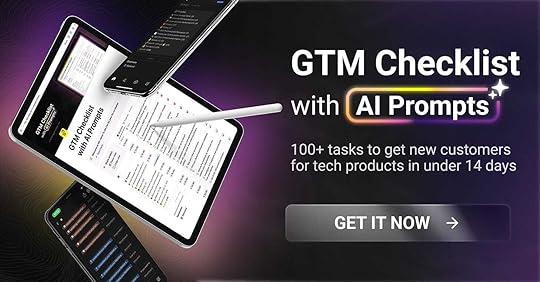
June 6, 2025
Growth Loops - The Key to Exponential Growth
Want to be actionable about GTM this summer? Grab resources, trusted by 8,000+ companies, at https://gtmstrategist.com/
Dear GTM Strategist,
No wonder that Growth Loops are one of the most beloved sections of my book and workshops. The pitch of “users getting you other users for free #viral” sounds like an irresistible offer.
It is also well-known that epic hyperpowers such as Miro, Calendly, Figma, and OpenAI have baked growth loops into the core growth features of their products.
 ChatGPT is one of the fastest-growing products in history.
ChatGPT is one of the fastest-growing products in history.BUT - this success is harder to replicate than one would expect.
It does sound simple in theory:
Growth loop = a user does something to attract other users to the product
But growth loops that really become a sustainable growth lever for companies are carefully engineered and baked into the product. To give you solid fundamentals in how you should be thinking and designing growth loops as growth features, this article will systematically walk you through:
What are the growth loops
Difference between growth loops and funnels
5 types of growth loops
How to supercharge growth loops with AI
How you can start implementing growth loops in your business.
So let them spin, people! 🔁
Growth Loops: Secret Engine That Makes Products Scale Themselves“Compound interest is humankind’s greatest invention - and growth loops are the best example of this.”
Most growth initiatives drive linear results - or no results at all. To break out into exponential scaling, you need growth loops: systems where your existing users become the engine for new user acquisition (and often activation and retention). Bring one user in, and they bring more users to your product for free - or at very low customer acquisition cost (CAC). That’s why Ognjen Bošković calls them “legal Ponzi schemes.”
Instead of a linear path: “Prospect → Sign-up → Butts in seats 🤠” growth loops feed back into themselves: one user action creates an output that brings in new users.
And that is not some kind of revolutionary idea, they have been kicking in since forever. In my village of 2000 people, there are 5 hairdressers. How did I select my go-to stylist? My neighbour had a sleek hairdo and I asked her who did it. She referred me to her stylist. Classic WOM (word of mouth) loop.
What is novel and great about the idea is that we, product makers, can initiate and influence this process by engineering growth loops into our products.
According to Reforge, a true Growth Loop is a closed system where every action a user takes drives new user acquisition, activation, or retention - creating compounding growth over time without constant input from paid or manual channels.
It becomes a self-reinforcing cycle. Each iteration builds momentum, turning modest traction into a hockey-stick trajectory.
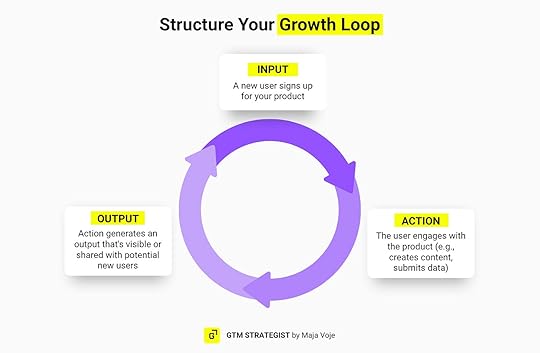 The simplest way to start thinking about growth loops.
The simplest way to start thinking about growth loops.Mapping every stage - identifying the trigger, the actor, and the motivating value - gets you compounding acquisition. When loops are firing, you’re no longer selling to individuals. You’re building a system that “sells itself”.
Long story short, here is why we 💜 Growth Loops:
They give you leverage
Key to exponential growth
Near-zero CAC (Customer Acquisition Cost)
Account expansion + impact on activation & retention
The holy grail of Product-Led Growth
Funnels Light the Spark - Loops Ignite the ExplosionBack in 2010, when I started my career as a growth marketer, our go-to framework was The Pirate Metrics - AARRR (Acquisition, Activation, Retention, Referral, Revenue) by Dave McClure.
 The Pirate Metrics by Dave McClure focused on the marketing funnel.
The Pirate Metrics by Dave McClure focused on the marketing funnel.This model sparked a mini-revolution back in 2010s. If you are feeling nostalgic, here is the OG: https://www.slideshare.net/slideshow/startup-metrics-for-pirates-long-version/89026
Funnels gave us a clear path, something that we can work with: fill the top with ads, optimize activation flows and retention and earn those conversions and referrals. BUT, practical problems that emerged with this linear kind of thinking resulted in silos, deterministic thinking of “one-off customer journey”, and grossly underestimating diminishing returns as we and our competitors were pouring in ka-ching into our funnels to outbid each other.
But it’s not a question of “funnels versus loops” - it should be “funnels and loops.”
Funnels still light the spark. Paid ads, manual outreach, or whatever it takes to hit critical mass. But once shares and invites start pouring in, build the loop and let it spin. Loops break down silos, slash CAC to near zero, and create a more sustainable path to growth than relying on funnels alone.
Product leader Aakash Gupta highlights 7 key differences between growth funnels and loops that will help us bring this point home:
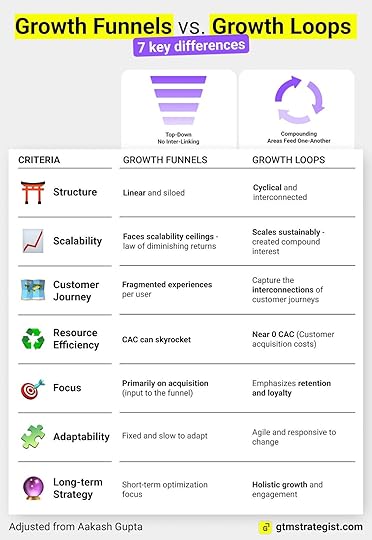 Funnels optimize stages. Growth loops compound momentum.
Funnels optimize stages. Growth loops compound momentum.I do not entirely agree about long-term - I think that funnels and growth will happily coexist for many more years before AI agents transact with each other through MCPs and we’ll no longer need user interfaces 🤖 - hehe.
By now, you must be hungry for some examples of growth loops - so let me serve. 🥧
5 Types of Growth Loops: How to Turn Users into Your Best MarketersWhenever I start explaining growth loops to someone (keynotes, workshops, mentorship sessions, my book), this is the hero visual that really helps them “get it”. Below are the 5 core growth‐loop archetypes I detail in my GTM Strategist book. Each one shows how you can turn customer actions into self‐reinforcing acquisition channels:
 This visual went viral on LinkedIn more times than I can count. Feel free to “steal” with credits.
This visual went viral on LinkedIn more times than I can count. Feel free to “steal” with credits.Since you probably have hands-on experience with all of these products, these examples really resonate. 5 types of growth loops defined with examples:
Viral Growth Loop: Emotionally resonant, shareable content sparks massive reach. Spotify’s “Wrapped” drives a tidal wave of social posts at the end of the year. Other examples: Duolingo, TikTok, Instagram.
Usage-Based Growth Loop: Core functionality naturally gets shared. Loom videos auto-play for viewers, who then sign up to record. Other examples: Calendly, Zoom, Docusign.
Referral Growth Loop: Happy users invite friends in exchange for perks. Dropbox rewarded free storage every time you referred someone. Other examples: Uber, Airbnb, PayPal.
Collaboration Growth Loop: Shared workspaces require new users to join. Figma files require sign-ups to comment or edit. Other examples: Miro, Google Docs, Notion.
User-Generated Content (UGC) Growth Loop: User contributions fuel discovery and sign-ups. Quora’s Q&A threads get indexed, pulling in readers who then ask their own questions. Other examples: Medium, Reddit, Stack Overflow.
Big question: Which type of Growth Loop can you leverage?
Pro tip: Lean on the existing customer journey. Where would users have the most motivation to invite others? Search for buckets of success in your existing customer data and plan experiments for those growth features before you go all-in on a project to build a growth loop. Just copying your competitor or company you admire will rarely work.
Unlock Hypergrowth: Infuse Your Loops with AIAnd then came mainstream AI, which was called machine learning in the past, and companies have been using it for decades to provide us with better customer experiences. Now it is widely available to companies that lack the capacity or simply don’t have a need to build and train their own AI models.
Since 90% of my clients are developing AI products - I had to think about what we can do for our beloved AI creations - how can we fuel AI for AI :) (so meta!)
This is my best bet so far:
 Products that use AI in their growth loops.
Products that use AI in their growth loops.A quick recap:
Viral Growth Loop: Leverage share-worthy, emotion-driven AI outputs to spark mass interest. Sora by ChatGPT lets users generate stunning visuals and post them everywhere - each view drives new sign-ups. Other examples: Midjourney, Stable Diffusion.
Usage-Based Growth Loop: GitHub Copilot suggests code snippets directly in a developer’s IDE. When collaborators review shared code, they notice Copilot at work and want their own access. Other examples: Jasper, ProWritingAid.
Agentic Loop: A website integrates ElevenLabs voice agent to answer visitor questions in real time. Prospects amazed by conversational AI responses sign up to use the voice generator. Other examples: Intercom AI, HubSpot’s ChatSpot.
Template Loop: Create AI-powered templates or components that require users to join to use or edit. Notion AI users publish workflow templates to a public gallery; new viewers import them and must sign up. Other examples: Figma AI, Webflow AI.
Referral Loop: Create an affiliate program to bring in more users. Lovable users get a unique referral link and earn a 10% commission from the first 6 payments made by any new customer who signs up through their link. Other examples: Copy.ai, Frase.
Would you change or add something?
This time, REALLY - hit a comment, reply to this email or DM me. I would love to continue working on this model based on your inputs and best practices, too. Can you help?
Last word of wisdom: I see a lot of greed, simplistic thinking, and laziness when people are crafting their first version of growth loops. “Simply copy the competitor, make users share branded image if they are on FREE, make them invite 3 friends to unlock higher tiers” - those things rarely work, and if they do, it is because they are aligned with the customer journey.
Building a growth loop is not a piece of cake, not everybody can do it, but if you find and validate pockets of success in your existing user base or if your brilliant product team builds something that is a “no brainer for user to crave more of and would make them look great if they share it” - you have a fair fighting chance.
 Define the role of growth loops in your customer journey.
Define the role of growth loops in your customer journey.All the models and frameworks mentioned here can be yours if you get my 100+ tasks Go-to-Market checklist with AI prompts. Enjoy compounding growth - I hope one day, I’ll share your examples here ✌️
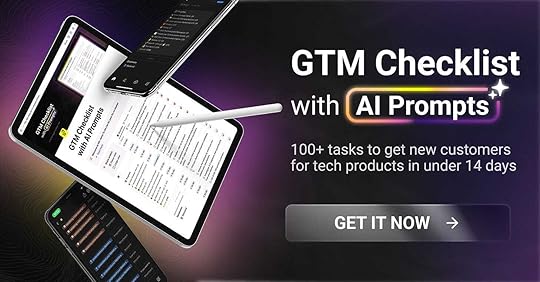
Sources for this article:
GTM Strategist by Maja Voje
The Product-Led Geek: The clever Snyk growth loop using GitHub Pull Requests
Interview with Ognjen Bošković for my book Go-To-Market Strategist
Reforge: Growth Loops - Transcending AARRR Frameworks
May 30, 2025
The Multi-Million Mistake Most Founders Make
Dear GTM Strategists!
Meet the person who has been challenging me the most about the scaling stage on GTM on LinkedIn :D
As you probably know by now, GTM fit is a wonderful moment in time when stars align and you've got yourself a predictable and scalable go-to-market (GTM) motion. Yet the route to get there could be rocky.
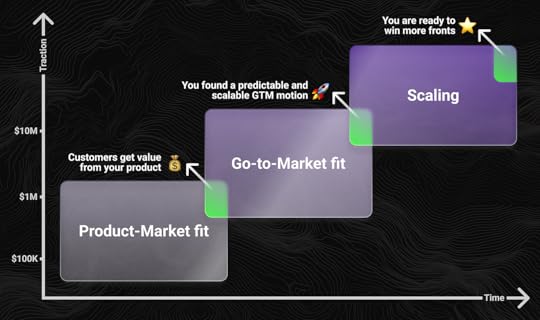 Once you've validated product-market fit and built a repeatable GTM motion, you're ready to scale with confidence.
Once you've validated product-market fit and built a repeatable GTM motion, you're ready to scale with confidence.Meet Björn W. Schäfer, entrepreneur and business angel, who has devoted his career and best-selling book to tackling this question. He will walk you through his Flywheel Effect framework and help you grasp how you can get those KPIs under control and align the processes in a way that you can maybe take a week of vacation this summer.
For me, this is one of the most challenging stages as a founder: mindset-wise, you have a transition from "eh, it will only take me 10 minutes to do it, would probably take it longer to explain it" to building teams, SOPs, and letting go.
It is hard, but as the cloning technology from Kamino (high five fellow Star Wars fans) is not available to us just yet, we have to transition there with humans and AIs that we have in our ranks today.
Let's see how Björn's framework could help us plan for a scaling stage in GTM.
The Concert That Changed EverythingPicture this: You're watching a B2B startup perform on stage. Each department—Product, Marketing, Sales, and Customer Success—has their own instrument. But instead of creating harmony, they're fighting for the spotlight. Product is playing a complex jazz solo while Marketing pounds out pop beats. Sales is screaming rock lyrics while Customer Success tries to conduct classical music.
The result? A cacophony that makes the audience cover their ears.
This is precisely what happens when your GTM teams aren't aligned.
But what if I told you there's a different way? A way where each department plays in perfect harmony, creating a symphony that doesn't just attract customers—it turns them into raving fans who keep coming back for more?
Welcome to the Flywheel Effect.
 Why Most B2B Startups Get Growth Wrong
Why Most B2B Startups Get Growth WrongHere's the uncomfortable truth: many B2B SaaS companies are burning cash on growth strategies that will never scale.
They're obsessed with lagging indicators like MRR growth and total customers acquired, but they're missing the fundamental principle that separates success from failure:
Sustainable growth comes from segment penetration, not market expansion.
The most successful SaaS companies don't try to boil the ocean. Instead, they master the art of going deep before going wide. They recognise that one customer success story in a focused segment is worth more than ten scattered wins across different markets. A similar principle applies to horizontal products, where dedicated use cases stand out. The rhythm isn’t particularly glamorous, but it is highly effective. Transform early market traction into repeatable customer impact. Do more of the same and secure similar clients. This is how you gain unstoppable momentum.
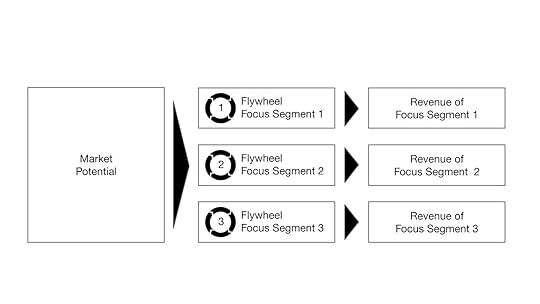 The Formula That Turns Early Traction into Self-Accelerating Growth
The Formula That Turns Early Traction into Self-Accelerating GrowthAfter working with 150+ B2B startups from Pre-Seed to Series B, I've distilled sustainable growth into a simple formula:
(Force - Friction) × Speed = Accelerated Segment Penetration
Let me break this down:
Force = Your targeted efforts on high-value segments
Friction = Internal inefficiencies and external market resistance
Speed = How quickly you can move customers through your flywheel
But here's the kicker: Most founders focus on adding more force (hiring more salespeople, increasing ad spend) when they should be reducing friction and increasing speed.
 The Four Pillars of the Flywheel EffectPillar 1: Segment-Obsessed Customer Selection
The Four Pillars of the Flywheel EffectPillar 1: Segment-Obsessed Customer SelectionStop trying to serve everyone. Start by identifying your most promising segments with surgical precision based on:
Deep Customer Base Analysis
Ideal Customer Profile (ICP)
Persona mapping across the Decision Making Unit (DMU)
Cohort-based performance analysis
Strategic Market Scoring
Speed of change in the segment
Urgency to solve the problem
Competitive landscape density
Market size and growth potential
Product-Segment Alignment
Current product capabilities vs. segment needs
Roadmap priorities and development timeline
Time to value optimisation potential
Real Example: A B2B software company discovered that while they had customers across 12 industries, 80% of their expansion revenue customers came from two verticals with employees between 1,000 and 5,000 using SAP ERP systems.
The result? They focused exclusively on these verticals and increased their win rate from 25% to 47% while cutting their sales cycle in half.
Pillar 2: Compound Pipeline GenerationMost companies treat lead generation like a numbers game. The Flywheel Effect treats it like a compound interest machine. Not just for Jason Lemkin, founder of SaaStr, the lead velocity rate (LVR) is the most critical metric SaaS companies should measure. While monthly sales merely document a result (lagging indicator), the key figure, the qualified Lead Velocity Rate (LVR), provides a clear preview of future growth (leading indicator) in real-time. Push it further and track your lead growth month-over-month, by segment:
SLVR (Segmented Lead Velocity Rate) Method =
(This Month's SQLs - Last Month's SQLs) / Last Month's SQLs × 100
You want to go the extra mile?
Don't just measure total SLVR. Measure it by share of ICP and progress by cohorts:
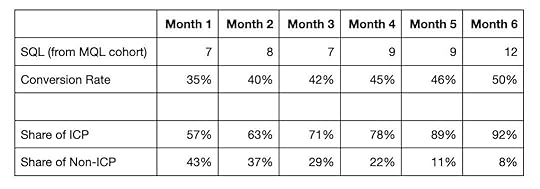
The Hidden Pattern: Notice how conversion rates improve as ICP focus increases? This isn't correlation—it's causation. When your team knows exactly who to target, everything improves: messaging, qualification, closing speed.
Power Move: Companies that double down monthly SLVR in their focus segments typically see x faster ARR growth than those focused on aggregate numbers.
Pillar 3: Focused Pipeline ConversionGame-Changing Insight: Throughout the entire customer journey, from Awareness to Consideration to Expansion, it is beneficial to prioritise or actively disqualify prospects and customers that are not a good fit. Startups I work with using a structured sales and discovery framework see 40% higher win rates and 30% shorter sales cycles. Could be SPICED, MEDDPICC, or my own CUSTOM Framework (remark: My book includes an entire chapter on this important topic):
Context Understanding
Urgency-Solution-Fit
Stakeholder Mapping
Total Alternatives Assessment
Outcome Quantification
Mutual Action Plan Development
The Compound Effect: Here is a real-world example from one of my clients and its impressive impact over three years:

The result?
At the original state, the sales velocity was 87,500 ARR per month, after implementing it skyrocked to 250,000 ARR per month (taking the current pipeline of 50 deals). However, the compound effects for years 2 and 3, based on the NRR of 115%, are even more impressive.
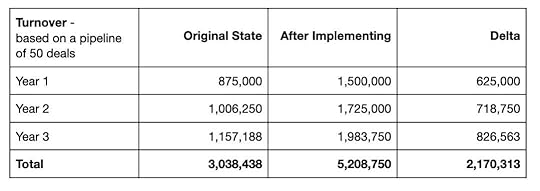 Pillar 4: Segment-Penetration Excellence
Pillar 4: Segment-Penetration ExcellenceThe leading indicator that predicts your future. While most founders obsess over lagging indicators (MRR, ARR), the Flywheel Effect is powered by leading indicators.
The Game-Changer: Leading Indicators for Retention and Time to Value (TTV) in your focus segments. Define a specific, measurable event that correlates with customer success:
Example: "75% of customers in Segment 1 who complete 3 specific actions within 30 days have a 92% retention rate vs. 36% for those who don't."
The Five Criteria for Bulletproof Leading Indicators:
Objectivity - No room for interpretation
Measurability - Automatically trackable
Customer Success Alignment - Directly tied to value creation
Value Proposition Alignment - Reinforces your positioning
Simplicity - Easy to understand and act upon
Power Move: Make this your North Star metric. Just imagine board meeting presentations where leading indicators for retention and time to value (TTV) are the main KPIs, rather than revenue growth and total ARR. Just imagine companies where product, marketing, sales, and customer success all optimise for the same leading indicators of success. The flywheel would start accelerating exponentially.
The Multi-Million Mistake Most Founders MakeFounders try to scale before they've achieved segment mastery.
They see initial traction and immediately think: "Let's expand to new markets, new use cases, new customer types!"
This is exactly backward.
The Flywheel Principle: Go deep before you go wide. Master one segment before expanding to the next.
Real Example: A client had moderate success across 5 different segments. When they focused on one core use case, they:
Increased win rates from 25% to 45%
Cut sales cycles from 12 months to 6 months
Achieved 142% NRR
Built a referral engine that generated +20% of new pipeline
The NRR Segment Mastery Effect:
Your Net Revenue Retention rate isn't just a metric—it's your growth engine. But here's what most founders miss: NRR must be measured by segment, not aggregate.
Real Numbers:
Segment 1: 142% NRR
Segment 2: 105% NRR
Over three years, the compound effect is staggering. Starting with 1,000,000 ARR in each segment, the Year 3 Results are:
Segment 1: 2,016,400 ARR (+102%)
Segment 2: 1,102,500 ARR (+10%)
That's an uplift of 913,900.00 in ARR!
The Compound Interest of Customer ExcellenceWhen you achieve segment mastery, every satisfied customer becomes a force multiplier:
Reference Engine: Similar companies trust recommendations from peers
Expansion Accelerator: Deep product adoption leads to bigger contracts
Referral Machine: Happy customers in one segment know prospects in the same segment
 The Flywheel Effect will help accelerate your GTM journey from early customers to the ideal customer profile (ICP).
The Flywheel Effect will help accelerate your GTM journey from early customers to the ideal customer profile (ICP).Whereas traditional companies see Customer Success as overhead. Flywheel companies see it as their best growth investment.
The Flywheel Effect isn't just another growth framework—it's a fundamental shift in how you think about building a SaaS business.
Stop asking: "How can we get more customers?"
Start asking: "How can we get more of the right customers?"
Stop prioritising: Lagging indicators like MRR growth and total ARR
Start prioritising: Leading indicators like segment-specific Lead Velocity Rate and Time to Value
Stop optimising: Individual department metrics
Start optimising: Cross-functional flywheel acceleration
The companies that master this approach don't just grow faster—they build unstoppable momentum that compounds over time.
The Flywheel Promise: While your competitors spread themselves thin chasing every opportunity, you'll become the undisputed leader in your chosen segments. Your customers will become your best salespeople. Your growth will compound. Your flywheel will spin faster and faster until it becomes unstoppable.
Your next step? Pick one segment. Go deep. Build your flywheel. Then watch as your focused approach creates exponential returns that scattered efforts never could.
The stage is set. Your instruments are tuned. It's time to create the symphony of growth that turns your startup into a market-dominating force.
Are you ready to spin your flywheel?
Want to dive deeper into the Flywheel Effect? This framework comes from Funky Flywheels, the definitive guide to Go-to-Market excellence for B2B startups. Based on insights from 150+ companies and proven in the trenches of European SaaS growth.
The world doesn't need another generic B2B SaaS or AI startup. It needs companies that master their craft, serve their customers exceptionally, and build flywheels that create unstoppable momentum.
About the Author: BJÖRN W. SCHÄFER is a highly trusted voice in the B2B startup ecosystem across Europe as the founder of Rowing8, podcast host, and business angel. He has shaped the growth journeys of over 150 B2B startups from pre-seed to Series B, accumulating more than €250 million in ARR and funding rounds led by 20VC, Google Ventures, Cherry Ventures, Creandum, UVC, Atomico, and HV Capital. His unique insights have earned endorsements from leading investors and industry veterans.
Get the GTM Checklist with AI Prompts ✨Go-to-Market Checklist with AI Prompts includes 100+ actionable tasks designed to help you win new customers for tech products in under 14 days.
Packed with proven templates, examples, and detailed AI prompts, it guides you from launch planning all the way to profitable, scalable growth - faster and smarter.

May 23, 2025
5 GTM Programs I Am Implementing With My Teams
Dear GTM Strategist,
In 2025, it is harder than ever to find something that is working and scale it - or is it?
Contrarian hook masters on LinkedIn claim that outbound is dead, inbound is AI-polluted, ICPs suffer decision-making fatigue and carefully save their budgets for rainy days … Yet we are still here working and getting good results with my teams. Why?
Because we have to make it happen. Reading about what is not working and feeling depressed about where the world is going does not help. The only thing that helps is action: doing things, not facepalming about why you did not start two years ago when it was “easy.”
This is why I decided to take you on a journey to see what GTM programs we are implementing in Q2 and share some templates so that you can find something that works well for you and get ready to scale.
In this post, you will get a glimpse of:
Radical focus by orchestrating everything to hit OKRs
Outbound motion with a case study (AI enrichment)
AI-assisted inbound motions
Agencies as an ICP and/or partners?
Positioning/messaging beyond “we do X for Y” (multiple ICPs apply)
For reference, I mainly work with AI companies that are preparing for $5-20 million investment rounds and are ready to unlock their next million ARR. Exceptions apply if I really like the product and the team and think they have lots of potential.
1) OKRs as a prioritization toolIf you are an entrepreneur who is fundraising or a consultant, you will LOVE this one.
You have to hit your targets and the only way to do that is to stare at them every single day and prioritize the use of your resources (time, people, budget) through the lens of “how likely or not will this help me achieve my goals?” In other words, “Is it mission-critical?”
 OKR (Objectives and Key Results) framework for goal-setting
OKR (Objectives and Key Results) framework for goal-settingI’ve always been bullish on the OKR framework for goal-setting because if you don’t know where you are going, how will you know that you got there? But I took them to the extreme in this quarter - every task that goes into sprints has to support a specific OKR.
Steps to implement this logic:
Develop OKRs - that is “the easy part” - use this free template.
Critically evaluate what “great looks like” and bake it into your OKRs. Avoid vague input metrics (like “publish 4 blog posts and 20 LinkedIn posts” - honey, I can do that in 1 hour with ChatGPT, but it is not what great looks like 🤠). A task can be done or it can be done right - you curate what is done right based on your standards of execution excellence.
Align them with your stakeholders - get feedback and ensure the key results sensibly add up to the objective. It will shock you how helpful that will be - you will unlock so much buy-in and get help.
Import your OKRs to your project management tool (most of my teams use ClickUp or Notion) - make sure you make them actionable, add owners and tasks.
Connect OKRs with your sprints so that all the tasks we add there have a streamlined way to get to operations.
Make a plan (“roadmap”) for tackling your objectives and build assets and processes needed to execute key results if needed.
Start every GTM sprint by reviewing OKRs. When tackling objectives with your team, make sure that every action point you make adds up to OKRs. If not, I would double-think whether to invest my resources there. OKRs are such a great tool for keeping focus.
Adjust if necessary - in GTM, nothing is set in stone. Every week, you learn something new. But NEVER adjust OKRs because of execution issues - you can always find a better agency, consultant, or change processes to make it happen. Don’t give up easily just because some people are too lazy or distracted to get the job done.
Trust me. This one is a game-changer - if you will ONLY take that from this whole article, you will see a positive change if you know what you are doing in business.
I even use this system in my personal life and have trained a voice ChatGPT personal assistant to give me pep talks whenever I am not feeling like doing another outreach, post, or meeting. Its generic voice: “Remember, every email you send, you are one step closer to your goals,” weirdly gets me fired up to stick to my goals even without immediate gratification.
Now, back to tactics.
2) Outbound with a hook - Case studyEvery company I work with has done something valuable before we started working together. Turning those wins into case studies helps attract similar clients who need the same solution.
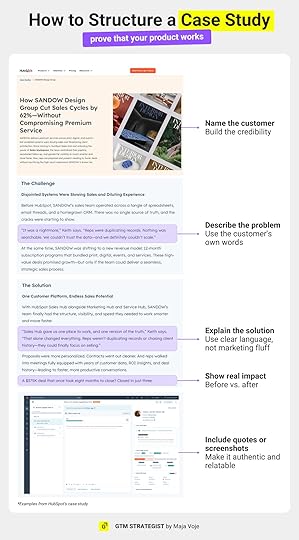 Don’t miss these elements when publishing a case study
Don’t miss these elements when publishing a case studyWith our teams, we are building a lead list based on targeted signals that a company might be interesting, and the outbound sequence looks a little bit like this:
Reference to the signal (confirming the problem)
Building authority
Adding value with the case study
Getting them to demos
But as always, the devil is in the details. Here are some mistakes I often capture when coaching my teams on how to prepare a high-quality case study.
Avoid these mistakes with a case study and outbound:
ChatGPT writes a case study based on a competitor/company you like. That is a great start - but you will have to add more “meat to it”. Think steps, screenshots of solution architecture, interview with a client, outlining resources needed… Clarify whatever is a common concern or question that you get on a call.
Just pitching like “Hello - got problem with downtime in your plant? We have solved this successfully for a company X, here is a case study link.” Wrong. You literally squeezed all the outreach sequence within the same message - you neither got their confirmation of a problem nor their permission to share this high-value asset with them.
Smashing a blog post of LinkedIn links to attract attention - come on, you can be more exclusive and give them value beyond sending them an infographic that you have created for your LinkedIn post. That is just underwhelming - there is nothing exclusive in it for them.
Overall, I am a fan of designing case studies well and clarifying in the call to action what they can expect if they book a demo.
Don’t just publish your case studies to your blog or website and “let them live their own life”. It doesn’t work that way; you have to bring relevant traffic. How? Make a distribution plan - whatever is relevant to your ICP: outreach, events, webinars, feature the link on your LinkedIn profile, make it more prominent on the website… You got this!
3) AI-assisted inbound motionStill with me? Good. Let me introduce the best seller in Q2: AI-assisted inbound motion. It’s so hard to find competent copywriters who understand your domain and the channel that you are trying to dominate with your thought leadership.
Let’s be honest, for an average person who could assist you with copywriting for thought leadership, it takes 3-6 months to “get the industry” - if they are motivated to learn. And most of the early-to-mid-stage GTM companies don’t have the budgets and skills to attract world-class talent.
So I like to team up with engineers to create custom AI content writers for my teams. We have to do something, and in most cases, the chances of training AI well are higher than getting decent people to work on our technical content.
This is an MVP that we usually implement:
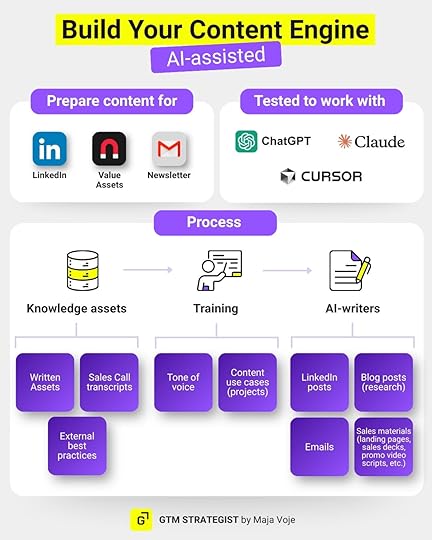 Train your AI tools to help you with content production
Train your AI tools to help you with content productionThis is super easy - everybody can do it. You just need a premium access to AI of your choice. Now - the fun part begins: we are trying to connect this “engine” with other processes such as getting insights from the customers, preparing texts for images, validating designs, generating content out of “thin air” on the go - super fun field to play in and it is already bringing good results for my technical teams. By now, it cuts 60% of the time needed for content. Hopefully we can get this number up to 80% by September.
I was thinking a lot about all-in-one solutions lately - these are the conversations I had with my partners Miro, Amplitude, Tidio, Momentum… Our ICP does not need a combo of 70 different tools to get the job done. Ideally, we can cover this within a single streamlined workflow that leads to success. We are trying to frankenstein our way into this philosophy with these builds - so grateful to work with amazing engineers who can make this happen. 🙏
4) Agencies as an ICP and/or partners?First rule of quick adoption: don’t change the existing workflows. Great that your AI solution can reduce 90% of the time the clerk will need to process a form, but the larger the organization is, the more likely they will need something more custom to exactly fit their existing workflows. Plus, maybe you will have to work hand-in-hand with an external service provider (agency, advisors, consultant, “Deloitte”...) to make it happen. An agency that implements your product can become your gateway to customers.
Surprisingly, I have seen this pattern at 50% of B2B AI agents that I am working with. We are not killing the middleman - the middleman is actually a huge amplifier of traction. So much so that some of my teams have even deployed a whitelabel solution and added multiple accounts fields to their products to capture their needs.
How they treat “the middleman” is different - some think of them as adoption partners and give them discounts for clients + fees. Others just roll out a pricing package for them. But in any case - pay close attention if “agencies” are within your early adopters bucket. If they are, hop on at least 20-50 interviews to know how they are using the solutions, what their problems are, and what an ideal solution for them looks like.
I have seen that a lot in the outbound ecosystem- Clay’s because of the head segment were outbound agencies, before they expanded to in-house teams. Heyreach, LinkedIn outbound tool has a pricing purposefully tailored for agencies + what they call “a generous affiliate program”, and Warmly is just updating their partnership program, leaning heavily on agencies - more info soon.
 Clay’s “beachhead segment” were outbound agencies
Clay’s “beachhead segment” were outbound agenciesThe biggest mistake I see here is “set it and forget it”. Every day, I get “are you open for affiliate partnerships” pitches and by now, I do not even bother to get back. Why would I care, what is in it for me for my clients and me, do I even see the use case of this solution?
Less is more when it comes to that. Instead of pitching 400 agencies a week, hand-select a list of partners that you will white-glove through the first batch of partner program and secure successful implementations. You are still learning at this point and working hand in hand with partners is the best way to start crafting a partnership process that will one day be a repeatable and scalable GTM motion.
5) Value props for the win: Positioning and messaging beyond ICPsAs AI agents are moving beyond “we do X for Y”, as we are expanding with new ICPs and adding partners to the decision-making process, our positioning and messaging should evolve. We work with a lot of VERY technical (I mean I have to call three friends who work in the space to really get it) products and I love that because it is one of the best possible intellectual challenges for me to tackle.
I love the idea of vertical AI agents and I have written about that extensively already for Userpilot’s PITT, but lately we got a lot of platforms for building AI agents and complex enterprise-grade solutions to our client mix, so we had to revamp some of our models to serve the multiple ICPs (multiple value propositions scenarios) better.
The lion's share of our work is to simplify the value proposition (what is in it for the customer - what is your promise) and provide a structure of information that backs up these claims with benefits, features, and pieces of social proof (evidence). My partner Anze leads these projects and here is a snippet of the process he does with our clients:
 A simple process for ICP-focused messaging
A simple process for ICP-focused messagingThere is a 6th program in the making: three clients are thinking about open-sourcing their AI agents instead of offering a free trial/demo, but it is too soon to dive into that because it is still in the making.
And #7 could be pricing for AI solution to nail the credit system … hehe - OK, I’ll stop - geeking out now
Hope you enjoyed this one.
What is working well for you so far in 2025?
Hit a comment and help others to build predictable and scalable ways to find customers.
Templates and workshop screenshots in this article are available here.
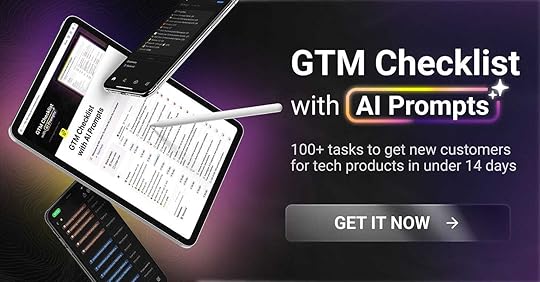
If you would like to work together, I am pretty stretched ATM, but feel free to let me know what you need to make your GTM work for you (not vice versa) - simply hit reply if you are reading on email or send me a DM on LinkedIn. I’ll try my best to help or offer you a trusted and verified recommendation for someone who can help.
May 16, 2025
The Growth Leader’s Playbook for Scalable Experimentation
Dear GTM Strategist!
Every week, I talk to 20+ entrepreneurs, VCs, consultants and business ecosystem leaders. There is one question that I ask at the end of every call:
“What is the hardest thing in your business?”
And lately, the most frequent answer to this question has been growth.
Budgets are getting tighter, uncertainty is suffocating investments, and AI has accelerated the law of diminishing returns, eroding ROI on channels and tactics that used to work very well.
Getting something to work is harder than ever.
Scaling something exponentially more so.
Not to be too pessimistic, whenever business seems stuck, I like to return to the essentials: are we purposefully solving the problem and have a system that enables us to learn, or are we scattering experiments all over the place in hopes of hitting the jackpot?
I invited Andrew Capland, PLG advisor who helped over 50 teams , from early-stage startups to $100M+ SaaS companies, including Copy.ai, Sprout Social, Pendo, Lusha, and Wistia to get unstuck on their growth journey.
In this post, he’ll break down the exact frameworks, docs, and rituals that have worked again and again across different companies, stages, and team setups.
This guide is for growth leaders, marketers, and product teams tired of scattered tests and shallow results. You’ll learn how to:
Spot and prioritize high-leverage ideas
Test faster and smarter
Build a learning loop that compounds
Make experimentation second nature
But first - why do most teams get stuck in the “just run more tests” phase?

This post is sponsored by Tidio. Tidio’s customer support AI agent, Lyro, guarantees a 50+% resolution rate with hassle-free setup and no strings attached.
Installed by over 300,000 businesses, Tidio is a complete customer service platform that consolidates your support requests from live chat, email, and social media into one dashboard.
See Lyro AI Agent in action in a live sandbox:
Why experimentation is so importantExperimentation is the process of learning and iteration.
The inputs to eventually figuring out what works, and scaling your business.
In the early days of a company, success is often measured by shipping. This is typically called the 0-1 stage of growth. You need to build the first version of many of the core components of the business:
Product positioning
Acquisition channels
New user onboarding experience
Pricing and packaging
Checkout and upgrade flows
Etc
 GTM Power Hour template includes the key elements for the 0-1 stage
GTM Power Hour template includes the key elements for the 0-1 stageBut once those first versions are live, that’s when the real work begins. Because what got you here, won’t get you to the next stage.
To grow faster, you need to figure out which parts of your experience are working… and which ones are holding you back. Then iterate and improve those experiences to help you break through plateaus.
That’s where experimentation comes in.
It’s not about testing for testing’s sake. It’s about learning what works, and what doesn’t. And to do it correctly, you need a system. A way to identify where you should test, how to brainstorm impactful ideas, prioritize them based on their potential, and then learn what works/doesn’t. A way to turn ideas into results.
And the faster you can learn what works/doesn’t - the faster you can grow.
The 4 main components of a high-impact experimentation programYou can’t actually learn what works (at scale) without a clear system behind it.
You can’t just throw ideas at the wall and hope something sticks. You need a repeatable process. One that helps you spot opportunities, generate strong ideas, prioritize what matters, and ship consistently.
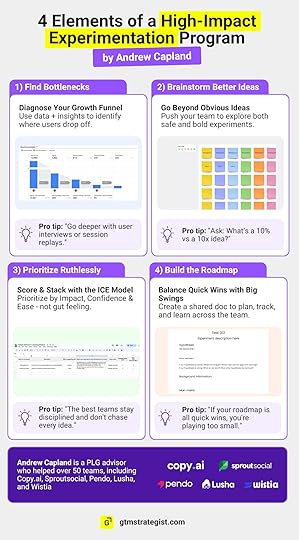
Let’s walk through each part of that system.
1. Find the bottlenecks in your growth modelA good experimentation program starts by knowing where to focus.
Start by zooming out.
Look at your entire growth model from acquisition to activation, retention, and monetization. Ask yourself:
Where are the major drop-offs?
Which areas aren’t converting well?
Which areas are underperforming?
Where are you lacking volume - or quality?
… and if you could fix those things, which will have the biggest impact on your business?
This is the time to merge quantitative and qualitative insights.
Dig into your analytics to spot trends and drop-off points—then go deeper using user interviews, session replays, support tickets, and in-product surveys. Quant tells you where users struggle. Qual helps you understand why.
You need both.
It’s a mistake to jump into testing without first doing this diagnosis work.
When you skip it, you end up solving the wrong problems.
2. Brainstorm 10% tweaks and 10x swingsOnce you’ve identified the bottlenecks, it’s time to start brainstorming ideas.
But not all ideas are created equal. Some are safe, obvious, incremental. Others are bold, creative, and high-upside.
This is where I use 10% vs 10x thinking.
Ask yourself (and your team): “What’s a 10% improvement we could make?” Then: “What’s a 10x change that could reinvent the experience?” The tension between those two lenses surfaces stronger ideas.
For example, let’s say you’re a B2B SaaS company looking to increase your purchase rate.
Ideas that might result in a 10% improvement in purchase rate might look like:
Updating the H1 on the pricing page
Adding FAQ copy at various points in the checkout flow
Improving the nurturing for users who have visited the pricing page, but not converted yet.
Ideas that might result in a 10x improvement might look like:
Changing the price of the product from $199 to $99
Making the free plan less generous
Shifting from a free plan to a free trial (or reverse free trial)
Don’t just settle for color changes and button copy. Push your team to think bigger.
That’s how you stumble into the experiment that changes everything.
3. Prioritize ruthlessly with ICEOnce you have a list of ideas, the next step is deciding what to test first. This is where teams can spin out, because everything feels important.
The ICE framework gives you a way to compare apples to apples.
Score each experiment by Impact, Confidence, and Ease (on a scale of 1–5), then calculate the average. This forces you to weigh your bets based on potential, not emotion, excitement, or seniority.
 How to determine Confidence for your experiments
How to determine Confidence for your experimentsThe best teams are disciplined here. They don’t chase every idea. They find the right ones.
4. Create a roadmap with quick hitters and big swingsA good roadmap is balanced.
You need some quick wins. Experiments that are fast to build, easy to ship, and likely to move the needle. But you also need big swings. Bets that take longer but could unlock transformational growth.
If your roadmap is all quick hits, you’re probably playing too small.
If it’s all big bets, you’ll burn out before you see any wins - or it’ll just take forever.
Mix the two. And always build from a shared doc. I recommend a centralized backlog with your backlog of ideas, current tests in progress, and key learnings, so the whole team can stay aligned and see the compounding impact of your work.
Let’s explore docs next.
The docs that power your experimentation programWe’re not documenting for the sake of it.
That’s how you drive visibility, alignment, and (most importantly) speed. There are three core docs every growth team needs.
They’re the operating system behind the scenes.
1. Experiment backlogThis is your single source of truth for all potential tests that your team(s) have brainstormed.
You can do this in a project management tool, but I personally like to use a spreadsheet tool. Each row should include:
What area of the growth model are we testing
A description of the test
Whose idea was it (in case we need to ask clarifying questions later)
A clear hypothesis on why we’re excited about the idea
The target success metric or part of the funnel
An ICE score (Impact, Confidence, Ease)
Status (not started, in progress, completed, etc.)
Link to the full experiment doc

When clients bring me in to help build out their growth function, this is one of the first docs I ask to see.
Not because I want to judge their ideas.
But because it tells me everything I need to know about how they work.
2. Experiment docsThis is where you define what you're testing, why, and keep tabs on the details.
Here’s what I recommend including:
Hypothesis: we believe that….
What we’ll learn from this test:
If our hypothesis is right: What do we learn? Where else can we apply this learning?
If our hypothesis is wrong: What do we learn? What other hypothesis do we have?
Relevant background information
Main success metric:
Secondary metrics:
An overview of the test:
What the control looks like: either a screenshot or description
What the variation looks like: either a screenshot or description
Experiment design:
Launch date:
Test location:
Percentage of users tested: if applicable
Minimum sample size:
Time to analyze:
Kill criteria
Results:
Action items:
 Grab a downloadable copy here!
Grab a downloadable copy here!You don’t need a novel here. Just enough context so anyone on the team could pick it up and understand it. It should take 15 mins to create.
Write it before the experiment starts. Update it when the test ends.
3. Wins & losses trackerThis is your source of truth about what’s worked, and what hasn’t.
Every experiment, whether it succeeded or failed, should have a one-line summary and key takeaway logged here.

The goal isn’t to obsess over the win rate. It’s to build institutional knowledge.
Because otherwise, teams forget. New hires repeat old tests. And everyone wastes time reinventing the wheel.
Every quarter, I like to look back on this doc and ask:
What patterns are emerging?
Where are we consistently seeing wins?
Are we learning fast enough?
The compounding effect of this doc is enormous.
When it’s done well, it becomes a competitive advantage.
You don’t need a giant sample size to run great experimentsYou just need signal and a way to validate (or invalidate) your ideas quickly.
You might be tempted to run some paid traffic or even do some outbound prospecting to increase your sample size. But those traffic sources convert at extremely low rates (compared to inbound and other channels) and this often exacerbates this feedback challenge even more.
When traffic is low, qualitative inputs become your best asset. Support tickets, sales calls, user session recordings, customer interviews, churn survey responses - these are great sources.
Use them to identify patterns and surface areas of opportunity. But just because you're using qualitative inputs doesn't mean the tests should be scrappy. You still need process, prioritization, and rigor. Run them through the same brainstorming and prioritization process as high-volume tests. You still want to pick the highest-leverage opportunities.
When it’s time to test, don’t wait for statistical significance (because in a low-volume environment, you'll be waiting forever). Instead, validate with user feedback.
My teams did this constantly in the early days. We’d identify an area of opportunity, design a few options, and use a user testing platform to gather feedback. We’d ask specific, conversion-focused questions to understand whether users noticed the change, understood the value, or were more likely to take action.
If you're at a low-volume environment, this can be your superpower. You don’t need a massive sample size, just clear signals and good instincts.
If you’ve made it this far in the article, you know more about building a high-impact experimentation program than most teams.
You’ve got the frameworks, the docs, and the mindset to start running faster, smarter, more impactful tests.Whether you’re leading a small team or scaling a $100M org, the same principles apply: Find your bottlenecks. Brainstorm impactful ideas. Prioritize with discipline. And build the habits that turn experiments into momentum.
If you found this helpful, I put together a free 5-day email series that walks you through how to avoid the most common mistakes when building and running growth experiments.
It’s packed with the lessons I wish someone had handed me when I first started out.
If you want to save yourself (and your team) a lot of wasted time, you can sign up here.
May 9, 2025
The Hidden Execution Crisis: Why Humans as the Data Layer Is Breaking GTM
Jonathan Kvarfordt, Head of GTM Growth at Momentum.io, is one of my favorite people in the GTM AI space. We have done prompts together, he started the state of AI in GTM report and now he is on a mission to solve a human data entry problem - when he pointed out that sales reps capture <1% of what buyers say. A typical sales call has 8,000 words while a typical CRM note has 25 words. It became painfully evident that we are losing tons of intelligence in GTM.
Intelligence from customer calls has been pivotal for creating unique insights and personalised campaigns for my teams. We process customer calls transcripts for everything - sales decks, LinkedIn posts, personalization of outreach and offers - it is a treasury of insights. Jonathan will take us one step further - why even the conversation intelligence is not enough to create a true edge.
If you are at least semi-serious about RevOps and GTM automations, this one will be a treat for you, since it is very strategic and applicable for building GTM orgs. In case you are a solo player, feel free to skip to the 🎁 list of prompts or dive in anyway, because these issues will follow you down the line or may be relevant for your largest customers.
P.S.: All the visuals are from Momentum sales deck, if you need some inspiration.
The Quiet Collapse of ExecutionStep into any pipeline meeting today, and you’ll see a symptom of the broader problem. The team joins, expecting to talk strategy. They’re ready to pressure test deal assumptions, identify risk, and share what’s working. Instead, the session turns into a live Salesforce data entry session. Everyone watches silently while a rep scrolls through stages, updates next steps, rewrites close dates, or tries to recall who the economic buyer was. The strategy conversation never really starts. You’ve already lost.
This is literally what my life as an enablement leader has been for years. Pipeline meetings have devolved into operations catch-up because the system still depends on humans to input the data, make it visible, and interpret what’s happening. That or I and Revops or Leadership become data police having to constantly bug the team who is trying to take care of customers to update their information for some leadership request. It’s friction and causes issues at the highest level of frustration for all parties and impacts business.
Why This Crisis Exists: Humans Are Still the System of RecordMost GTM teams today still run on a system where humans are expected to be the originators of structured information. Sales reps are tasked with logging data that CRMs rely on. Managers interpret and repackage that information for leadership. Enablement tries to measure what’s happening in the field based on scattered recaps or one-off anecdotal feedback.
Everything hinges on whether a human remembers, records, or reports what happened. That assumption worked when GTM motions were smaller, cycles were slower, and buyers were more predictable. It doesn’t hold up in today’s environment—where speed, visibility, and adaptability are essential.
If your entire revenue operation depends on someone remembering to log the next steps, tag the decision maker, or flag a competitive risk, then your execution system is built on sand.
Execution Isn’t a Workflow Problem—It’s a Data Infrastructure ProblemLet’s clarify something. Most revenue leaders think their team has a workflow or process issue. That’s rarely the root cause. What they actually have is a structural data architecture issue.
The workflows break down because the systems aren’t instrumented to run automatically. They’re triggered by memory, by verbal check-ins, by post-call debriefs. So every automation or enablement effort ends up being reactive—responding to manually surfaced information instead of structured inputs that flow automatically from customer interactions.

Teams don’t struggle because they lack hustle. They struggle because their execution engine was never designed to produce consistent, structured signal without human intervention.
The implications are severe:
Forecasts are unreliable because deal stages and close dates are out of sync.
Coaching is misaligned because there’s no baseline view of how reps are actually running calls.
Playbook adoption is unclear because there’s no instrumentation to track usage.
AI tools underperform because they’re being applied to inconsistent or incomplete inputs.
 Conversation Intelligence Isn’t Enough
Conversation Intelligence Isn’t EnoughA lot of companies think they solved this problem when they bought a conversation intelligence platform. They didn’t. Recording a call and transcribing it is not the same thing as structuring the data inside of it.
Transcripts are raw material. Insight comes only when that raw material is parsed, labeled, and connected to the systems that matter—like Salesforce, Slack, or your enablement platform.
Without that connective tissue, conversation intelligence becomes another silo. It’s useful for reviewing calls and running coaching sessions, but it doesn’t power your system. It doesn’t trigger workflows. It doesn’t replace the need for a rep to type something into a CRM. It just gives you another place to go look for answers.
That’s why AI adoption doesn’t always move the needle. AI agents built on messy or incomplete data are just faster ways to produce bad outputs. The model isn’t the problem. The structure of your execution system is.
 The False Promise of AI Without Structured Signal
The False Promise of AI Without Structured SignalThis is where most companies get it wrong. They want automation. They want agents. They want predictive insight. But they’re trying to build that on top of human-entered notes and flat transcripts.
It doesn’t work.
You can’t automate what isn’t reliably captured. You can’t predict what isn’t consistently tracked. You can’t personalize what isn’t structured. If the system doesn’t produce clean signal from real buyer interactions, your AI initiatives will be performative at best and damaging at worst.

There’s a rush right now to adopt generative AI across the GTM stack. But what people are missing is that AI without structured data is noise. A thousand agents can’t help you if they’re operating off incomplete or misaligned inputs.
So the priority for revenue teams right now isn’t more tools. It’s better data architecture. You have to fix what your system is observing and how it captures that information before anything else will make a difference.
The Real Shift: Stop Treating Humans as the Data LayerThe core mental model that needs to shift is this: humans should not be the system of record nor should they be the data entry into a system of record. Their role is not to be the capture layer. Their role is to show excellence and build relationships with customers and prospects. The system’s job is to observe, tag, store, and act on the data.
Right now, most companies have that reversed. Reps are being asked to log call summaries, next steps, objections, competitor mentions, and more. Managers are expected to synthesize this into dashboards or updates. RevOps teams spend hours cleaning and correcting records just to build an accurate report. It’s no wonder strategic conversations get sidelined. Everyone is too busy keeping the system alive.

A modern GTM system must operate differently. Calls, emails, and customer interactions should automatically produce structured data that feeds into execution. Managers shouldn’t ask for updates. They should see them. Enablement shouldn’t guess at adoption. They should measure it. Leadership shouldn’t wait for QBRs. They should spot trends in real time.
This doesn’t mean removing humans. It means designing systems that support them with better signal, clearer insight, and less friction.
What This Looks Like in Practice
You don’t need to boil the ocean to start. But you do need to stop pretending that manual input is a viable strategy.
Start by auditing your key workflows. Identify where human action is the trigger for execution. That includes logging deal risk, updating fields, handing off to CS, or flagging competitor mentions. Ask yourself—what would need to be true for those workflows to run without asking someone to type anything in?
From there, shift your attention to the conversations your team is already having. These are your most valuable data assets. They contain the raw signal for everything: buyer pain, decision criteria, stakeholder dynamics, objections, urgency, and intent. The question is whether you can extract that information cleanly, consistently, and automatically.
You need a way to move from transcript to structured signal. That means detecting the right patterns, mapping them to CRM fields, and linking them to workflows. Whether you build this internally, stitch together tools, or use a platform like Momentum.io, the outcome is the same: execution becomes automatic because data becomes structured.
Here’s what starts working when you get this right:
Sales stages become accurate because they reflect actual buyer behavior, not guesses.
Coaching becomes relevant because it’s tied to what reps are actually doing, not what they say they’re doing.
Playbook adoption becomes measurable because every call is instrumented.
Forecasting becomes trustworthy because deal health is based on conversation signals, not just rep confidence.
Automation becomes valuable because it’s driven by real buyer data, not artificial triggers.
This is what an execution-ready GTM system looks like. It’s not built on effort. It’s built on structure.
How Momentum Solves It: Rebuilding Execution Around Signal, Communication, and AutomationMomentum was built to solve this problem at the root. Most platforms offer surface-level insights or dashboards. Momentum replaces the brittle, human-dependent execution layer with an AI-powered GTM system that runs on clean signal and structured action. It does this through three foundational pillars.
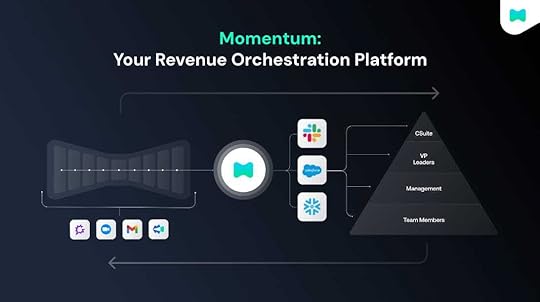
First, Momentum acts as a first-party data provider, turning unstructured calls, emails, and buyer interactions into structured, clean data. This isn’t transcription or summary. It’s precise signal capture—mapped directly to your CRM fields and GTM metrics. Every objection, stakeholder role, pricing discussion, or competitor mention is tagged, structured, and stored. No more relying on reps to fill in deal details after the fact.
Second, it delivers communication of the right signal, to the right person, at the right time—without bias. Reps, managers, and leaders each get surfaced what matters to them, when it matters, without waiting for manual rollups or subjective interpretation. Managers get alerted to real risk. CS gets notified when a deal is ready to hand off. Leadership sees strategic patterns emerging from real buyer behavior. Everyone gets aligned around objective, real-time truth.
Third, Momentum powers automation and orchestration, taking those structured signals and turning them into execution. Coaching workflows, CRM updates, Slack alerts, CS handoffs, and even internal deal reviews are triggered automatically—reducing time-to-action and keeping deals moving forward. There’s no need to wait for meetings or reminders. The system moves with your buyer.
Together, these three pillars—clean structured data, intelligent communication, and automated execution—transform Momentum from just another AI tool into the operating system for modern revenue teams. The result is execution that doesn’t depend on memory, doesn’t rely on meetings, and doesn’t break under pressure.
More than just Prompting with ChatGPT
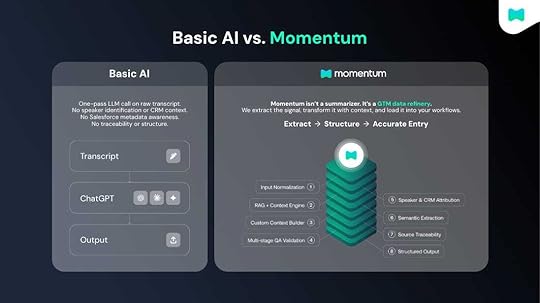
Most AI tools today offer little more than basic summarization. They run a single-pass LLM over a raw transcript, without speaker attribution, CRM awareness, or structured integration. The result? Flat output with no context, no traceability, and no real impact on execution. Momentum is fundamentally different. It acts as a GTM data refinery, transforming raw conversations into structured, validated, and CRM-ready intelligence. Using a multi-layered architecture—from input normalization and custom context engines to speaker attribution, semantic extraction, and structured output—Momentum doesn’t just summarize; it powers execution at scale. It extracts signal, applies context, and feeds accurate data back into your systems—so your GTM motion runs on precision, not guesswork.
The Cultural Shift: From Reporting to OrchestrationFixing execution isn’t just about data. It’s also about culture.
Right now, most GTM teams operate in a reporting culture. Reps report what happened. Managers report what’s going on. Leaders report what they think is next. Everyone’s translating, summarizing, or guessing.
That model slows everything down. It introduces noise and bias. It creates room for misalignment to fester. And it guarantees that your strategy will always lag reality.
The future is orchestration. In an orchestrated system, the data flows from the point of contact with the customer into the systems that drive execution—without needing manual translation. Your workflows don’t depend on meetings. Your insights don’t depend on memory. Your strategy is informed by reality, not anecdote.
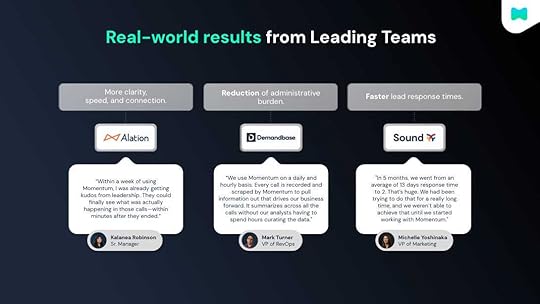
This is a fundamental shift in how revenue teams operate. And it’s the shift that separates top-performing orgs from everyone else.
Final Thought: Precision Execution Starts With the Right FoundationAI is not the answer unless you fix the architecture it sits on. Your CRM is not your source of truth if it requires constant human correction. Your enablement program can’t scale if it’s built on assumptions. Your forecast won’t work if it’s powered by stale summaries and guesswork.
Execution isn’t a department. It’s not a tool. It’s not a dashboard. It’s a system.
And that system either runs on clean, structured data—or it doesn’t run at all.
Don’t let the execution crisis stay invisible.
See how high-growth teams like 1Password, Ramp, Alation, Zscaler, Windsurf, Cherry, and more are using Momentum to turn raw conversations into structured, revenue-driving action.
Schedule your AI Transformation Session
Do you want free AI prompts to help you with ABM, sales, and all other go-to-market motions? Momentum launched a MEGA prompt library with 200+ AI prompts by senior GTM experts Nick Bennett, Jonathan Kvarfordt, Daniel Disney, Christian Krause - and also some of my prompts. Grab it now!

May 2, 2025
The No-Fluff LinkedIn Ads Playbook
I often get asked about LinkedIn ads as a GTM motion. For help, I turned to Karola Karlson, growth strategist and author of Marketing Fix newsletter & blog. Over the past 10 years, Karola has built the global marketing team at Bolt, advised 50+ brands on growth, and managed 6-figure Meta and LinkedIn campaigns. Check out her free Figma library with 155+ LinkedIn ad examples.
In this article, Karola will cover:
The right timing to consider LinkedIn ads
B2B brands running 5,000+ ad creatives on LinkedIn
The 12-week experiment to go from 0 to positive ROAS
Creative strategies for top- and bottom-of-funnel ads
Screenshots of exceptional B2B ads for inspiration
Recently, a London-based software company’s CMO asked me whether they should run LinkedIn ads.
Instead of a clear answer, my brain produced a Huel metaphor. (Yes, that Huel, the nutritionally complete drink that – you’d be surprised to find out – even normal people genuinely like.)
If you read a few Reddit threads on Huel, you’ll learn that people use it differently.
Some drink four Black Edition shakes per day. While others consume a bottle 1-2 days per week when they don’t have time for a real meal.
LinkedIn Ads, like Huel, work best if you use them to complement your other acquisition channels, be it for customers or nutrients.
As Maja wrote in her brilliant article on GTM motions, most companies discover that focusing on 2-3 growth motions is the sweet spot.
While bigger companies can run all these GTM playbooks simultaneously, smaller companies have to concentrate their much more limited resources on 1-3 motions before moving to the next one.
There's no one-size-fits-all package of GTM motions, as this chart will show.
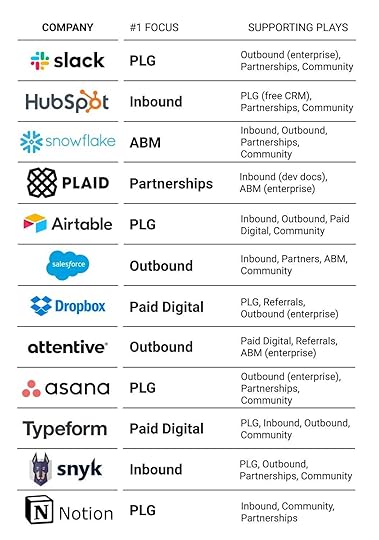
Here are some fast-growth B2B brands bidding on LinkedIn ads.
Based on the level of creative variety and scale, it’s fairly safe to assume that paid social is an integral part of their growth strategy.

Looking at the chart, note how the strategy and offers vary based on product type, ICP profile, and company size.
Also, note how many of these leading B2B brands have an insane number of ads in their LinkedIn Ad Library.
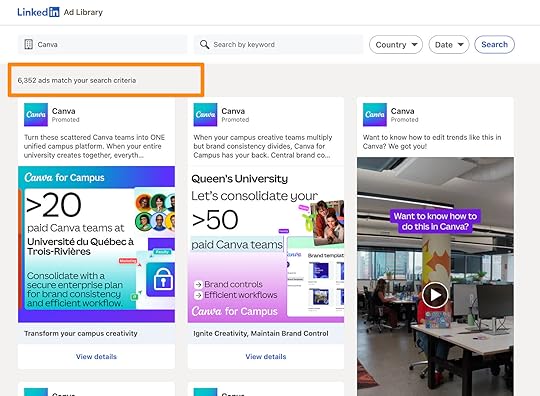
If Canva is running 6,000+ LinkedIn ad creatives, the channel must work really well for them. Right?
Right…
In my experience, LinkedIn ads are never The Channel with the highest ROI and lead/revenue acquisition volume.
However, allocating some of your budget (and time) on LinkedIn ads can be worthwhile if you’re looking to scale your existing acquisition channels, i.e. GTM motions.
The key to getting positive ROAS out of LinkedIn ads is approaching the channel strategically. Don’t throw in your dollars to just watch them burn.
Are LinkedIn ads the right GTM motion for you?If you’re intrigued by the idea of testing LinkedIn ads, but unsure whether the channel is worth the investment, consider these three questions.
1. Have you validated your product-market fit?In other words: Are you 100% sure that people need – and are willing to pay for – your product?
Have you validated your ICP (ideal customer profile), tested outbound sales, and converted leads into paying customers?
If the answer is no, there are cheaper and more pragmatic ways to work on your product-market fit than a paid ads channel with the average CPC (cost per click) of $15 - $100.
2. How will LinkedIn ads fit into your existing acquisition funnel?Based on my 10+ years of experience working with SaaS companies, LinkedIn ads work best when targeted at audiences in…
Awareness + demand generation stage
End-of-funnel + deal closing stage
I’ll expand on my go-to creative strategies for both stages later in this article.
For now, I suggest that you draw a quick napkin sketch of your conversion funnel, from awareness to prospecting to the actual revenue. Include your marketing and sales tactics for each stage.
Keeping in mind Maja’s wise words, “Invest in compounding channels,” ask yourself:
How do LinkedIn ads fit into your existing acquisition matrix?
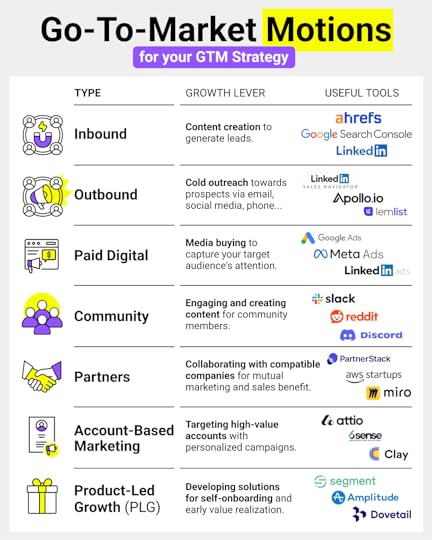
One thing that you certainly don’t want to happen is relying solely on paid acquisition for lead generation and revenue growth.
We’re no longer in 2010, the heyday of cheap social ads when it could be a high-ROI growth channel.
Sad, yes, but true.
3. What is the goal of your LinkedIn ad campaigns?Here are two additional questions to ask yourself, vis-à-vis investing in a LinkedIn ads experiment.
Do you need an extra channel for boosting your early-funnel leads?
This could mean adding more cold prospects into your Enterprise-level sales funnel, or free trial users/subscribers if you target SMBs (small and medium-sized businesses).
But first, I suggest maxing out on scaling your existing acquisition channels.
Achieve excellence in 1-2 channels, rather than working on 5+ channels with limited resources.

Have you reached the peak with your highest-ROI channels, both free (e.g. LinkedIn organic marketing) and paid (e.g. Google Search ads)?
If yes, it might be the right time to test LinkedIn ads.
Do you need additional brand touchpoints to convert prospects into deals?
Adding extra touchpoints to the pre-deal stage can help your sales team close more deals faster.
For example, thought leadership and customer testimonial ads help to build trust and elevate brand perception.
Consider running LinkedIn ads to complement your other acquisition activities, such as AI-powered sales, organic LinkedIn, newsletters, automated emails, etc.
TL;DR: Should I launch LinkedIn ad campaigns?Sometimes, if you can’t know for sure, the best thing to do is run an experiment.
However, paid ad campaigns won’t fix a bad product.
If you’ve got a solid product-market fit and believe that LinkedIn ads would complement your existing marketing channels, give it a go.
OK, I want to try LinkedIn ads. What’s next?Before you inaugurate LinkedIn ads into your ongoing marketing mix, I suggest that you approach it as a 3-month experiment.
Why three months, in particular?
For one, it’s unlikely that you’ll see positive ROAS in the first week.
The 12-week time period will give you enough time to experiment with different campaign optimisations, target audiences, and creative strategies.
It’s also a long enough period to demand a solid strategy – and a budget that should make you reluctant to say: “Let’s throw spaghetti on the wall and see what sticks.”

When running LinkedIn ad experiments for my B2B clients, I focus on creative experiments first.
Why?
On LinkedIn, just like on Facebook and Instagram, your ad creatives are the key element that either makes or breaks your campaign.
I would go as far as to say that ad creatives contribute 80% of paid social campaigns’ performance.
The other key factors include campaign setup, audience targeting, delivery optimisation, landing page and product/sales conversions.
But I’m getting ahead of myself!
In what follows, I’ll share my blueprint and suggestions for running your first ad campaign experiment on LinkedIn.
 Creating your LinkedIn ad experiment strategy
Creating your LinkedIn ad experiment strategyIn a nutshell, here are 8 steps to launching your LinkedIn ads experiment:
Define your goals and KPIs.
Set your experiment’s timeframe and budget.
Decide on experimentation frequency.
Document & prioritise experiment ideas.
Create your reporting & learnings document.
Set up LinkedIn Insight Tag and conversions.
Create your campaign drafts and audiences.
Design your first ad creatives & launch the campaign.

I will comment briefly on each point, with an extra focus on campaign structure and creative best practices.
Step 1: Define your goals and KPIsYou know it already, but I’ll nonetheless say it: Every marketing experiment needs clear goals that are reflected in specific KPIs.
Are you looking to get more leads, convert existing prospects, or move the needle elsewhere in your funnel?
Knowing your goal(s), you can choose the right campaign objective, optimise on relevant conversions, and evaluate your campaign performance and ROAS.
Step 2: Set your experiment’s timeframe and budgetThink about your budget as an equation.
How many results do you want to get out of the experiment?
What are your marketing funnel conversion rates? Ad click > landing page > conversion to lead or customer
What CAC (cost of conversion) are you looking to reach?
What ad campaign budget do you need to get X results at Y CAC?
Let’s see the calculation in practice.
How many results do you want to get out of the experiment? – 200 demo call signups
What are your expected marketing funnel conversion rates? Ad click > 15% > landing page > 22% > demo call signup
What CAC (cost of acquisition) are you looking to reach? – $100 per demo call signup
What ad campaign budget do you need to get X results at Y CAC? – 200 x $100 = $20,000
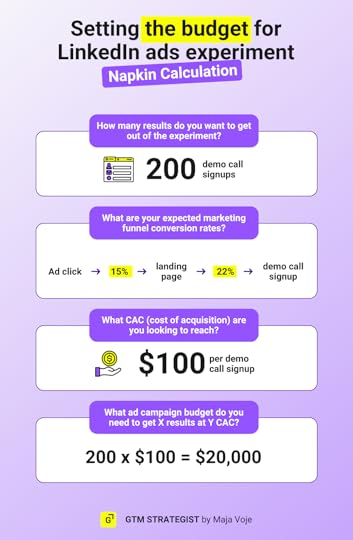
To get 200 results at $100 CAC, your total budget for the experiment is $20,000.
This is the ideal scenario of working with a single KPI that’s easy to track and attribute. But even when working with an incremental uplift, consider how you’re going to measure success – and how much the experiment will cost.
One frequent mistake that I see B2B brands make is running a 1-week LinkedIn ad campaign with < $500 budget and concluding the channel doesn’t work.
You’ve got to test, test, test to make LinkedIn ads work.
Step 3: Decide on experimentation frequencyThe more you experiment with your ad creatives, the more different audiences you will attract and convert. (Yes, the more spaghetti will stick.)
I recommend launching new ad creatives (with varied design and USPs) weekly over the first 6 weeks of your experiment.
After that, you can keep the top-performing creatives and experiment with audiences and campaign types.
Suggested LinkedIn campaign experiment schedule:
Set up and launch the new experiment(s) every Monday
Pause and report on the previous experiment (Monday)
Select & communicate the next idea to experiment with (Monday)
Work on the next experiment’s preparations (Monday-Friday)
Step 4: Document & prioritise experiment ideasThis one’s too obvious to explain.
So, to give you a ginger shot of inspiration, here’s a screenshot of the experiment planning sheet that I created for my B2B ad creatives course participants.
 Step 5: Create your reporting & learnings document
Step 5: Create your reporting & learnings documentAnother obvious recommendation, and yet one that so many marketers ignore.
Whenever you conclude a creative experiment, report on all variations’ results.
If you’ve ever run Meta or LinkedIn ads, you know what a struggle it is to go back to the Ads Manager and flick between past campaigns to understand which creative directions and messaging worked best.
I’ve tested (too) many different versions of ad creative reporting over the years, plus some tools.
This Google Spreadsheet report layout is by far the best I have found.

Add each new creative experiment on a new row on top of the document.
Over time, it will give you an immediate overview of every creative you’ve tested, plus a comparison of the best and worst-performing creatives.
It is easy to fill in, streamlined, and can be conveniently navigated.
Step 6: Set up LinkedIn Insight Tag and conversionsIf you’re not tracking the conversions from a marketing channel, you can’t assess its efficiency.
Simple logic – and in the case of most LinkedIn ad experiments, also a simple setup.
I found this chart about attribution methods, shared in a recent Growth Unhinged newsletter, a good illustration of various tracking options.
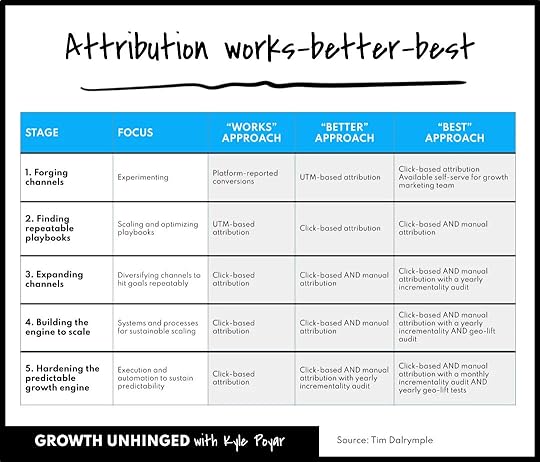 Source: Growth Unhinged
Source: Growth UnhingedFor LinkedIn ads, I recommend that you…
Set up the LinkedIn Tag on your website and in product, with all the relevant conversion events from lead to client stage.
Use UTM tags in all your campaigns to have an internal click-based attribution model.
If you run awareness or end-of-funnel campaigns, define the uplift attribution model before launching your campaigns.
By this point, there remain two topics to discuss:
Step 7: Create your campaign drafts and audiences
Step 8: Design your first ad creatives & launch the campaign
Luckily, I happen to know that the readers of GTM Strategist appreciate a good old long-form article.
So I’ll expand on both, sharing some pointers for campaign setup and ad creatives.
My go-to campaign structure for LinkedIn ad experimentsThe number one mistake that brands make when experimenting is to create a new ad campaign whenever launching a new test.
Number two is testing too many things at once.
Here’s a great illustration by ConversionXL, showing what will happen if you try to test too much stuff at once.
 Source: CXLBegin with one experiment campaign with a single ad set
Source: CXLBegin with one experiment campaign with a single ad setI like to keep all experimentation inside a single ad set until it delivers positive ROAS.
If you take my advice and begin by testing ad creatives:
1. Upload 5-6 new ad creatives into your test campaign (the same ad set) every week.
2. Pause all past week’s creatives once you’ve set your new creatives live.
Yes, you must pause the past week’s top-performing ads. Otherwise, the algorithms will keep preferring them to the newcomers.
Also, by starting basically from zero with a fresh set of creatives, you’re forcing the algorithms to adjust the audience that sees your ads. This in itself can lead to higher ROAS.
Why only 1 ad set with 5-6 ad creatives?You may ask: Why create only one ad set with all the tested ad creatives, like this?
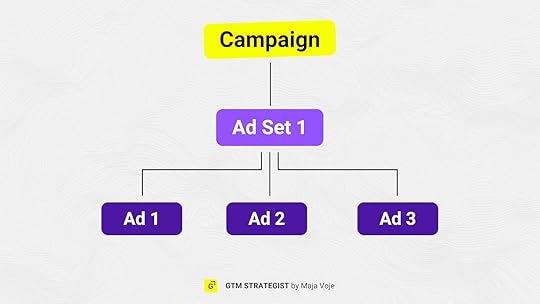
Instead of a setup where you have separate ad sets for each ad creative.

The reason for this is simple…
If you place every ad variation in a separate ad set, the algorithms will treat each ad set as a different entity.
Each ad creative will optimise for a slightly different target audience, because targeting works on the ad set level.
Also, by splitting each ad creative into a separate ad set, you will dilute the budget spend.
With 5 ad creatives, each ad set will spend 20% of the experiment budget.

Instead of giving the new top-performing ad creatives more budget, each tested variation will spend the same amount.
This leads to fewer results as the low-performing ads (and ad sets) attract and convert fewer potential customers.
For the same reason, I never use LinkedIn’s A/B testing features.
Found a strategy that works? Split your main & experiment campaignAfter you’ve found the recipe that works, you can split your experiment campaign from the main campaign.
One ongoing ad campaign, 90% of your budget
Separate experiment campaign, ca 10% of your budget
NB! Separate campaign groups for every target market / ICP.
If you work with several target audiences (ICPs – ideal customer profiles) or want to run experiments on multiple markets, create a separate campaign group for each.
This will allow you to control per-country and per-audience ad spend, and to upload localised creatives.
Alternatively, you can just run your experiment in one target market or on one ICP.
Got lots of target markets?
Experiment with new ad creatives and other campaign elements in your primary target market with the highest ad spend first.
After concluding the experiment, apply the discoveries to your other markets.
The foolproof LinkedIn ad campaign setupAs you might expect from a big social media platform, LinkedIn offers lots of different campaign setup options and automations.
But all that glitters is not gold, and sometimes (always), a simple no-fuzz setup will lead to the best results. (Read: the highest ROAS.)
➡️ Select a conversion-led campaign objectiveOption 1: Advertise for conversions, bid on conversions.
If you’re looking to increase conversions (leads and customers) with your LinkedIn campaign, choose the corresponding objective: “Website conversions.”
Option 2: Advertise for conversions, bid on clicks.
To place a maximum CPC bid, select the “Website visits” objective.
However, do not evaluate your LinkedIn ad campaign's success by its CPC. In the end, what matters is new revenue, i.e. conversions.
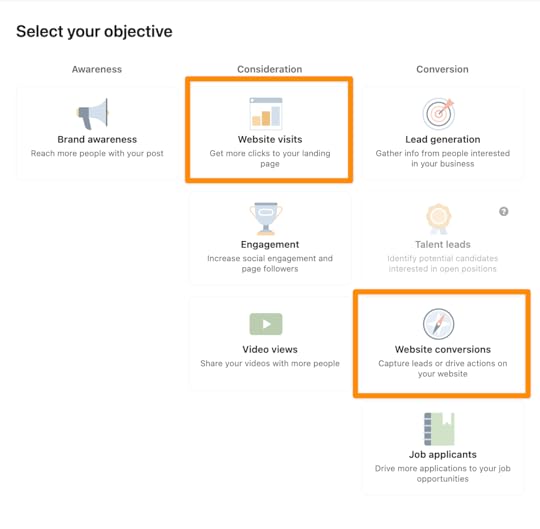
Option 3: Advertise for leads, bid on leads.
Last but not least, the “Lead generation” objective will allow you to run LinkedIn Lead ads.
It’s the ad format where a prospect shares their email and other information in exchange for your promoted guide or industry report.
Lead Ads can work well if you’ve got a sales team to move the leads further down your acquisition funnel.
➡️ Use manual bidding with a cost-per-result capLinkedIn CPC is expensive. I’ve seen the suggested bid go up to $90.
Start with manual bidding to cap the cost per click.
Place the initial bid at a 50% lower rate than what LinkedIn recommends. Every 24-48 hours, increase your bid by 10% until your campaign reaches the full daily spend.
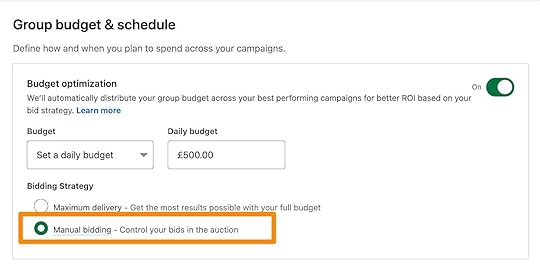 ➡️ Target a niche audience based on job roles
➡️ Target a niche audience based on job rolesContrary to Meta advertising, where you target a broad audience of 1M+ people and let the algorithms optimise your campaign delivery, on LinkedIn you want a narrow audience of 10-50k people.
You can expand the audience later, as your ad frequency and budgets scale.
Create your target audience based on job roles and seniority, and avoid automatic audience expansion:
Don’t target the audience network.
Don’t use audience expansion.
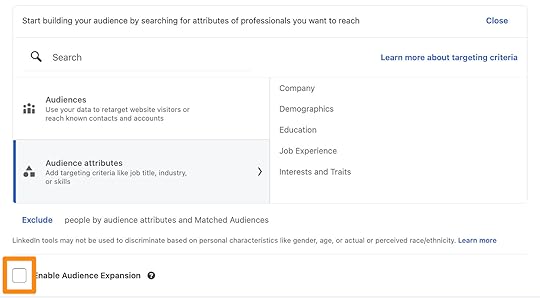 ➡️ Reverse exclude audiences
➡️ Reverse exclude audiencesI found this hack by going down the Reddit rabbit hole. And it’s proven to work well.
Problem: About 50% of LinkedIn users aren’t attached to a company page, so if you target companies with x number of employees, it’s not 100% accurate.
Solution: If you want to target smaller companies, apply the reverse targeting method.
Example: Instead of targeting companies with 1-50 employees, exclude anyone in companies with 51 or more employees. And vice versa.
You can also exclude sales, business development, and marketing roles to reach more decision-makers.
And don’t forget to exclude your existing customers and leads, unless you want to reach them.
➡️ Opt out of LinkedIn Audience NetworkYou’re paying a premium price to be advertising on LinkedIn, so you wouldn’t want to pay for clicks that happen elsewhere.
Exclude the Audience Network from your campaign placements.
 ➡️ Start with Sponsored Content Ads
➡️ Start with Sponsored Content AdsLinkedIn offers several different ad formats, each of which appears in a different placement on the platform.
If you’re in the stage of verifying whether a paid channel works for you, opt for the most popular campaign type. On LinkedIn, this means Sponsored Content ads.
Sponsored Content Ads are the in-feed ads that appear in your LinkedIn feed, next to non-sponsored posts. Variations include single-image, video, carousel, and lead ads.
On top of that, you can run Follower Ads, Dynamic Ads, Job Ads, Message Ads, Text Ads, and more. These ads appear in non-feed placements, e.g. the area right to the main feed and your InMail inbox.
Here’s a Dynamic Text Ad by LinkedIn itself that targets me.

The Dynamic Text ads are worth testing, albeit not as your primary ad format.
They’re almost free to run if you optimise for clicks. No one really clicks, but you can get your logo in front of your ICP. And this, in the long run, can make them subconsciously more receptive to your sales pitches and in-feed ads.
The Message Ads that appear in LinkedIn inboxes remain the greatest mystery to me. Why pay for InMail ads (that people hate) if you can simply do high-quality, personalised outbound outreach? If you know the answer, do tell!
How to fail-proof your first LinkedIn ad creativesIn a recent blog article, I wrote about LinkedIn ad mistakes… Made by LinkedIn itself.

Here’s a quick overview of the mistakes I identified:
Boring ad image layout
Missing call-to-action button
No illustration of the product or benefit
Eclectic colour scheme
Generic stock photos
Overcrowding ad image with text
Impractical information overload
Hidden or missing value proposition
Tiny product screenshots
No bold headline in ad image
My bet is that if LinkedIn’s paid advertising team fixed these blunders, their ROAS would improve 2x or more.
But unlike LinkedIn’s paid advertising team, you don’t have an unlimited budget to waste.
You need the results now.
Fortunately, there are hundreds of B2B advertisers nailing the LinkedIn ad creative.

I’ve collected 155+ screenshots of excellent LinkedIn ads in a Figma Library. Get it here, gather inspiration, and copy the best.
But before you go, read the last part of this article to learn the best practices for top-of-funnel and bottom-of-funnel LinkedIn ad campaign creatives.
LinkedIn ad formats & layouts for top-of-funnel campaignsIn the early-funnel stage, your LinkedIn ads should focus on one or more of these four objectives:
Inform your ICP about the benefits (USP) of your product
Establish your brand as an industry thought leader / leading provider
Build positive brand perception by sharing high-quality content
Feed new leads into your marketing or sales funnel (lead ads)
Begin by experimenting with single-image ads with one USP.
Launch ads with 1-3 of your primary USPs within a single ad layout. You can experiment with the wording of your USPs as well.
Do not mix messaging and layout tests for you won’t be able to tell which element (message or layout) worked.
Remember the BBB rule: high-contrast Background, Bold headline, single Benefit.

I’m a big proponent of using number-led USPs on ad creatives.
A big bold number pops out in the crowded feed and, like a picture, tells more than a thousand words.

Once you’ve found 2-3 well-performing messaging angles, begin experimenting with your ad image’s layout and colours.
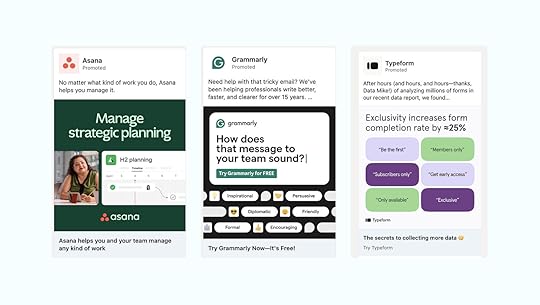
Avoid generic stock images and overwhelming screenshots of your product dashboard.
Instead, simplify your product features and make the non-text parts of your ad to communicate a story as well.
Once you’ve had some success with single-image ads, diversify your creative strategy.
Test video ads in collaboration with content creators, customer testimonials, and product introductions.

Advertise your team members’ organic posts with a high reach and engagement.
Run carousel ads that communicate your product USPs, showcase customer testimonials, or share valuable advice.
There are so many different creative directions to test…
Just spy on your favourite B2B brands in the LinkedIn Ad Library for infinite inspiration.
If you’re just getting started with LinkedIn ads, be wary of much creativity.
The foolproof way to reach positive ROAS is to avoid hyper-creative ideas, e.g. memes and riddled copy.
Value first, fun later.
LinkedIn ad formats & layouts for bottom-of-funnel campaignsIn the mid- and late-funnel stages, your LinkedIn campaigns’ focus will change.
Now, your creative strategy should stem from the question: how to support the conversion of leads to customers.
Down the funnel, your ad creatives should become more oriented on trust and proof points.
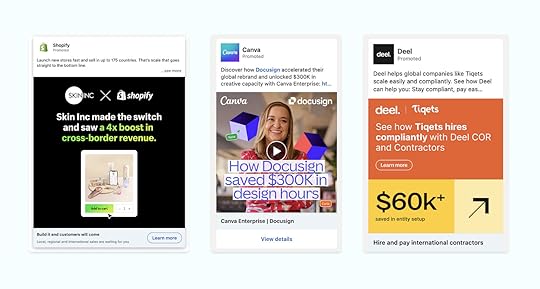
It’s best not to mix your top-of-funnel and bottom-of-funnel ad creatives.
So set up a separate retargeting campaign for lead nurturing.
In your retargeting campaign, test ad creatives that feature:
Customer testimonials and client logos
Customer ratings on review sites
Case studies with numbers
Media coverage about your brand
High-quality industry reports
Webinar & conference invitations

Update your ad campaign’s ad creatives at least every two weeks.
Even a simple change like a new colour scheme can draw additional people’s attention.
To sum up, LinkedIn ads can make a meaningful contribution to your GTM strategy, both in Awareness and Conversion stage.
Getting positive ROI out of this high-expense channel is contingent on the right timing, commitment to strategy, and relentless creative experimentation.
If you’ve got additional questions, or want to discuss a point I’ve made, find me on LinkedIn and Marketing Fix blog.
Additional resources:
Figma Library with 155+ LinkedIn ad screenshots
Marketing Fix newsletter on LinkedIn ad mistakes
Advanced B2B ad creatives course by Karola (Get 20% off with GTMSTRATEGIST code)



